¡andale! 🇬🇹 🇲🇽
If the tail end of Central America was difficult and had me questioning what I was doing, then mexico has been the trip distilled to the essence. The why’s and the what fors-answered by a line on a map. This is what I came looking for. The past several weeks have been marvelous, nothing short of incredible at times, with some challenging terrain and plenty of rain along the way.
It was still tough at times before the upswing; I promise we’ll get there. I left Flores headed for the Mexican border at a town called El Ceibo. The riding was tough but mostly uneventful. Temperatures regularly were well past 40 degrees Celsius before noon. The countryside was flat and hot and the sky colored gray by burning piles of litter and agricultural waste. My bike still had only one speed and I was making slow progress.
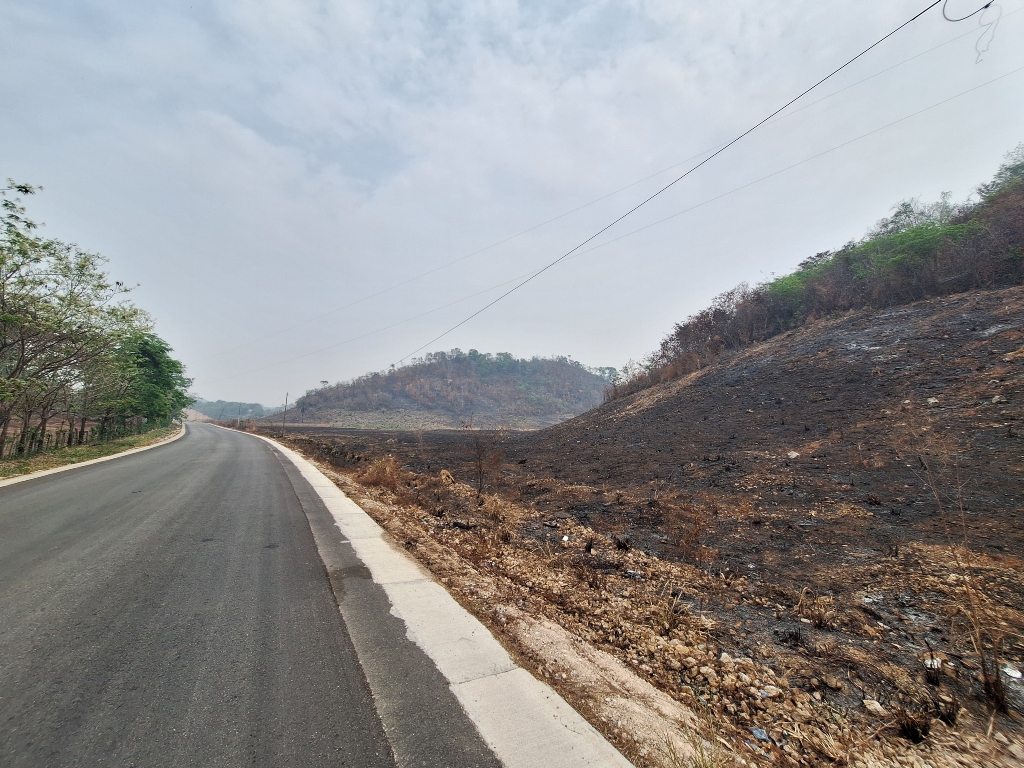
Common scorched earth agricultural practices
Guatemala wasn’t going to let me go without throwing a few more things my way. One afternoon, out of the blue I was sideswiped by a slow moving small car. His mirror caught the edge of my handlebars and I fell to the pavement. Another driver stopped to check on me but thankfully I was fine. I picked up the guys mirror that had broken off in the collision and I gave chase but quickly calmed down, not sure exactly what the plan was if I caught him. I remember two little girls looking back from the rear windshield at the cyclist chasing their car. Probably more aware and worried than the stupid driver. The car turned onto a dirt road and I stopped to check myself. I had landed weirdly on my heel and spent the next week or so limping. I still had the guy’s side mirror and had calmed down by this point. I saw the same model car coming my way and flagged down the driver. “How would you like a spare right mirror for your car, sir?”
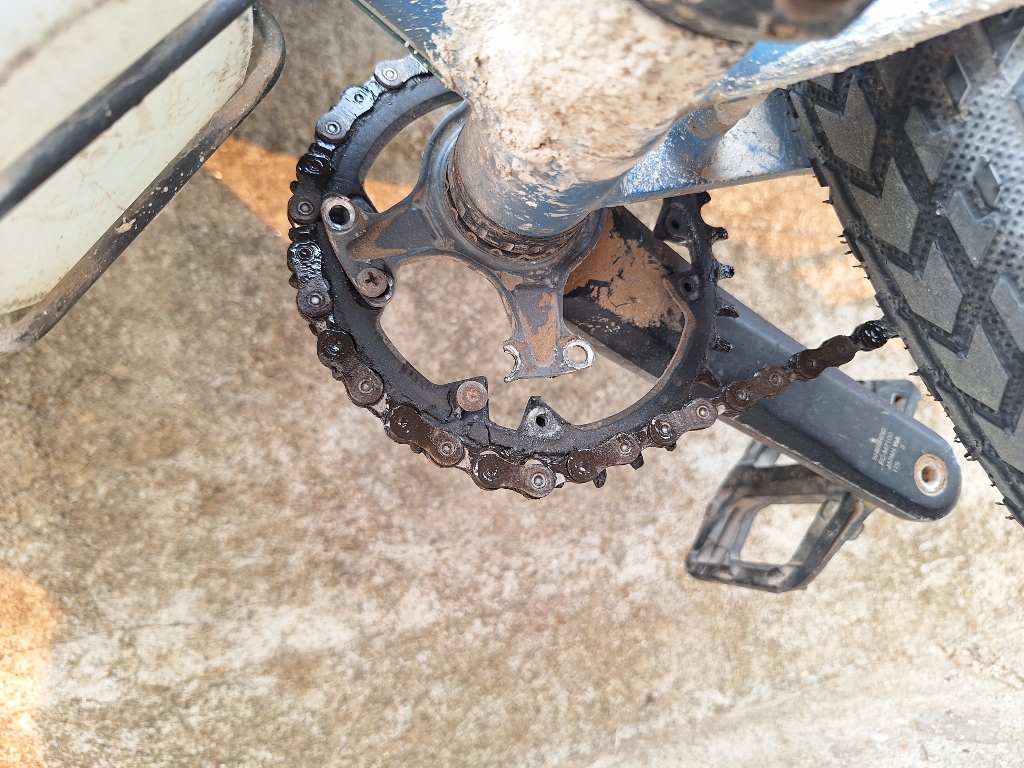
It's really finished now
As I rolled into the town of Caserío el Paraíso my front chainring met its end when it completely “taco’d”. After first starting to fall apart back in April of last year, about 15,000 kilometers ago, I’d kept it going with occasional trips to the ferreteria. The roadside fix by Gaspar about one week before would be its last. I began chatting with a man wearing a very cool cowboy hat and standing by the side of the road. I’d come to find out that Carlos spent thirty years living and working in the same town where I grew up. He knew someone who ran a bakery where I could camp out back tonight.
Mexico!
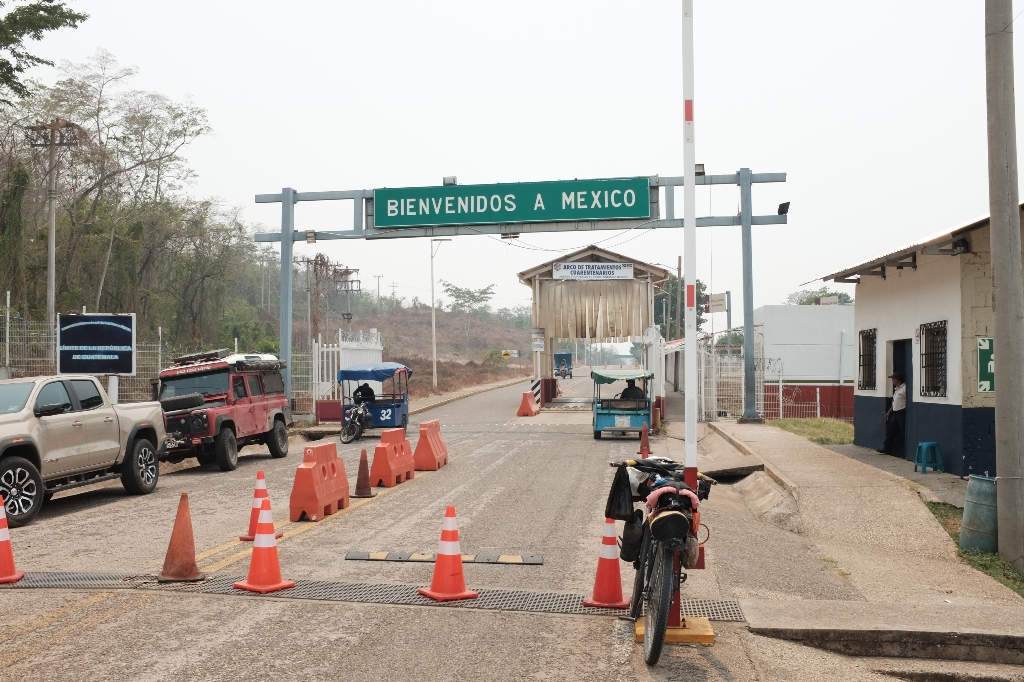
Entering Mexico
The bike was now unrideable and I wouldn’t be cycling for the next few weeks as I worked out how to get it fixed. The following morning I took a bus to the border and crossed into Mexico. It was the longest and most bureaucratic border crossing yet and took about three hours. I met another cyclist named Andrew from Philadelphia who was going the other way. The last collectivo bus to Tenosique had already left so I found a restaurant that would let me camp inside. I was right at the border but I was now in Mexico. The last “new to me” country of the trip; number fourteen.
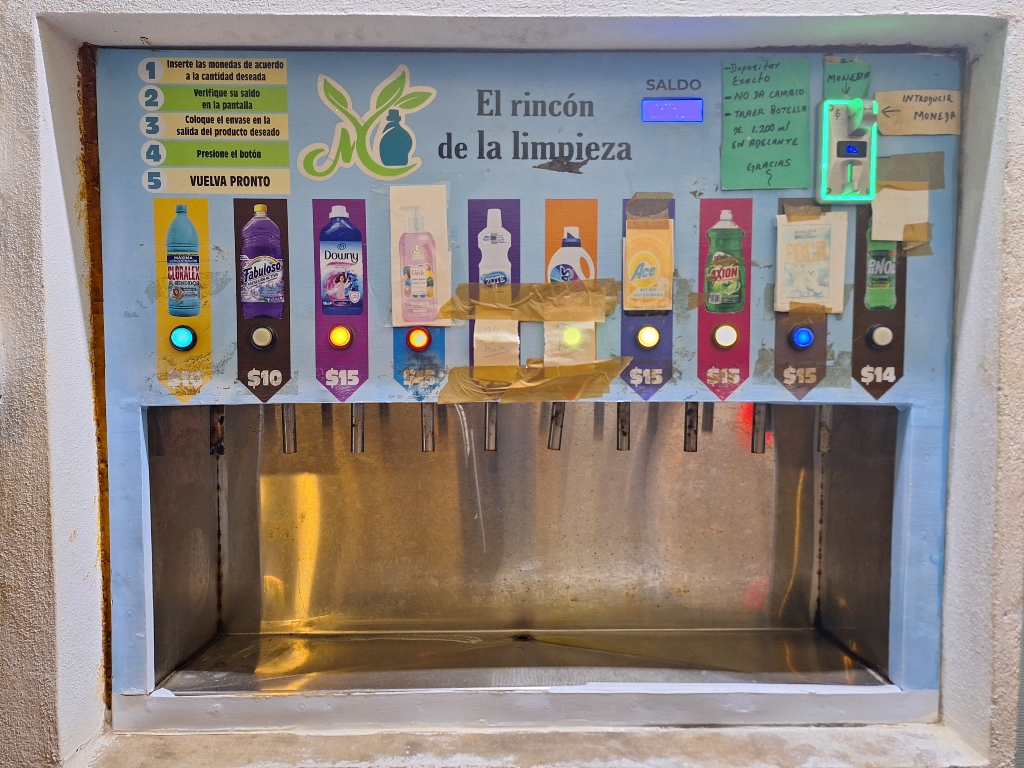
A neat street side detergent refill station in Palenque
The following morning I caught the collectivo bus to Tenosique and then a second bus to Palenque. It’s easy to be disappointed when taking a bus and “skipping” a section. My line through the Americas is far from perfect or continuous but if you’re open to it, the time spent in a bus can give you an entirely different perspective. Earlier, I had seen migrants walking down the road somewhere along the way in central America and it had become more common in northern Guatemala. Every so many miles the border patrol had a checkpoint where bus passengers were sometimes asked to identify themselves. Of the four or five checkpoints we went through, I was consistently the only one asked to show ID. I laughed to myself thinking how obvious a profiling target I made as the police officer stuck their head in through a back window, scanned the bus, and saw one head sticking out above the rest. On one occasion, just a few hundred meters beyond a checkpoint our van slammed on the brakes, someone threw open the sliding door, and two people jumped in; a young lady and a man in his 70’s. They gave a man outside a stack of Guatemalan Quetzals and off we went. It was brief, total chaos in the van that calmed as quickly as it had arisen. This was pretty normal for everyone in the bus, it seemed. These people were unable to go through the checkpoint so had hiked through the woods and then caught a bus on the other side. The two new passengers exited the bus about a kilometer before Tenosique. It was something I never would have seen on the bike.
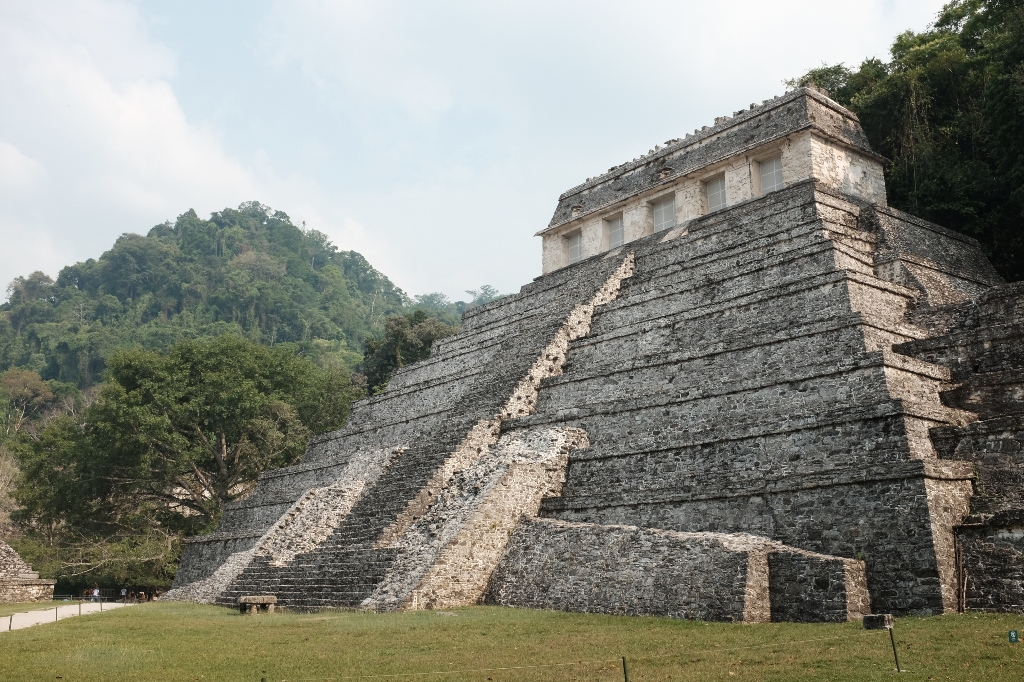
Templo de Las Inscripciones at Palenque
The second bus to Palenque was less eventful. Once I got there I found a couple on the outskirts of town that was looking to start their own hostel and had taken a first step by allowing travellers to camp on their porch. They even had a fan I could bring into my tent. It was pure luxury and I slept well for two nights, took a rest day, and visited the Mayan temple complex on the outskirts of town, one of the most impressive so far. From Palenque I took an overnight bus to San Cristobal de las Casas. With my bicycle’s drivetrain gradually showing its age over the past months, I had begun to make plans for replacement parts well in advance. I had come to see the drawbacks of the 12-speed derailleur system that I was using and had set my sights on something new. I have no regrets about using the setup that I had up until this point. The perfect bike for this trip is the one you already have. I’m convinced that the hardest part is starting and I think a lot of people never start because they’re hung up on trying to have the perfect bike. It doesn’t matter. What you’ve got will probably do just fine for whatever trip you have in mind. People will help you fix whatever breaks along the way.

And again...
You may be surprised to read that I’m not that into cycling. Not as a sport, at least. I’m completely convinced that it’s the best way to commute, to get around, or to see the world, but as a sport, it’s just too dependent on stuff. Lots and lots of stuff. Maybe it’s just a trap that I have a tendency to fall into, oggling a bunch of shiny bike parts, but I find the whole industry to be very consumerist. The bike has pretty much been perfected at this point and it seems like a lot of stuff just gets re-engineered to keep the lights on at Shimano or any other bike company. I want to mention that, yes, a friend of mine has pointed out to me the hypocrisy in trying to consume less by buying one final really fancy German bike part, but here I am.
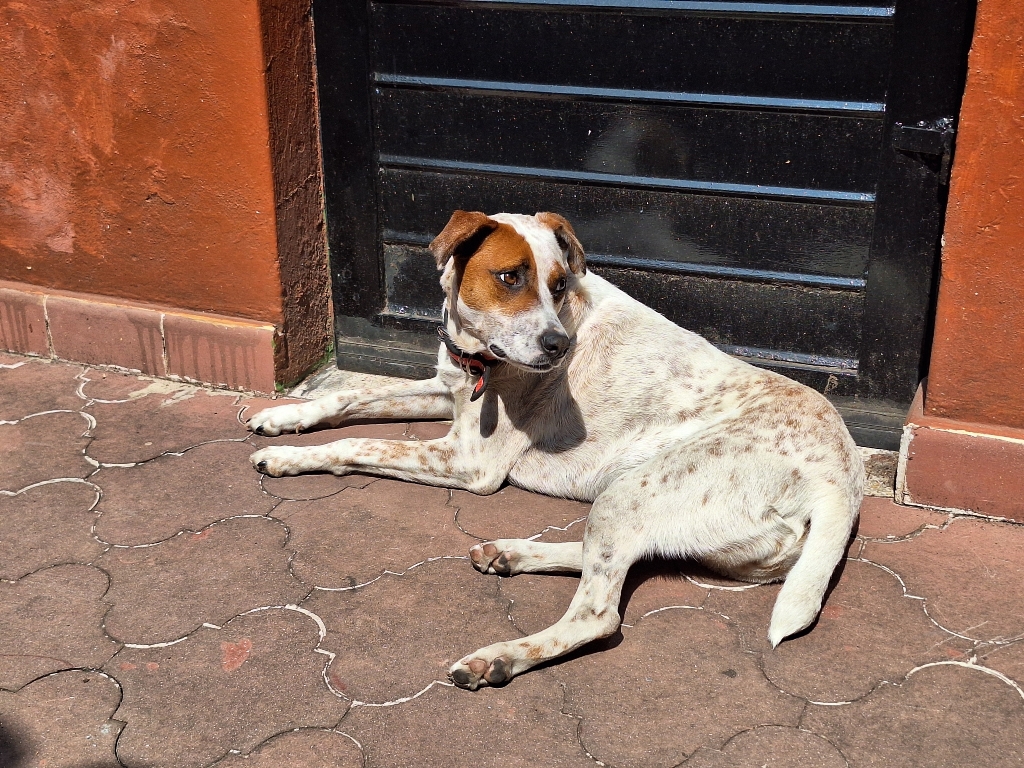
The hostel dog in San Cristobal
So a few months ago, after being convinced by a few other cyclotourists about the efficacy of the Rohloff internally geared hub, I began researching what I’d need to make the leap and ended up purchasing the hub and necessary parts. Now that my old drivetrain had completely fallen apart, I needed to somehow get the hub to me here in Mexico and what followed was an elaborate, diligently coordinated cascade of family and friends getting all of the parts to Mexico City.
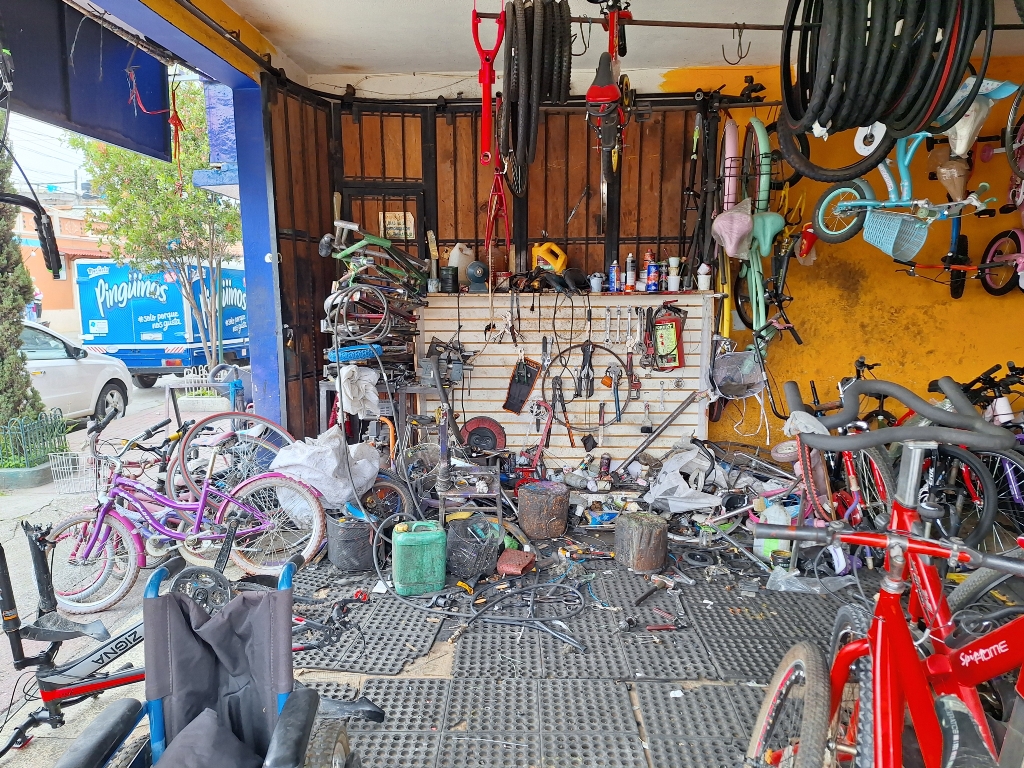
It's around here somewhere
I took one more overnight bus to San Cristobal de Las Casas, arrived early, found a hostel, and then accidentally napped until about four in the afternoon; I guess I needed it. With what remained of the day I went out and found some new glasses. My old ones had been broken by the crash in Nicaragua. At night in camp I had been wearing my prescription sunglasses and a headlight like a true fashion innovator, but this was getting old. Most optometrists needed two weeks to produce a pair and I wasn’t willing to wait but now due to the circumstances with the needed bike repairs, I’d probably still be here in two weeks. In San Cristobal I took my bike apart and stashed some parts at the hostel and took what I would need to rebuild the bike to Mexico City via overnight bus. After the crash I had begun looking for frame builders in Latin America that would be along my route. I found Básica Studio via this article. As welders of their own bicycle frames, I sent them some messages after the crash and they told me they could help me out, no problem. Surly, the manufacturer of my frame, also offered to send me a new fork. Sometimes the hardest part about this trip, mentally, is choosing a path to take and commiting to it and following through and dealing with all of the little things that go wrong along the way. You have all these ways to achieve something and you try to think of anything that can come up and the necessary contingencies but eventually you just have to get going; pick a road and cross whatever bridges you need to cross. After a long overnight bus ride I was in Mexico City and all of our effort had paid off. I and all of the necessary parts were in one place.
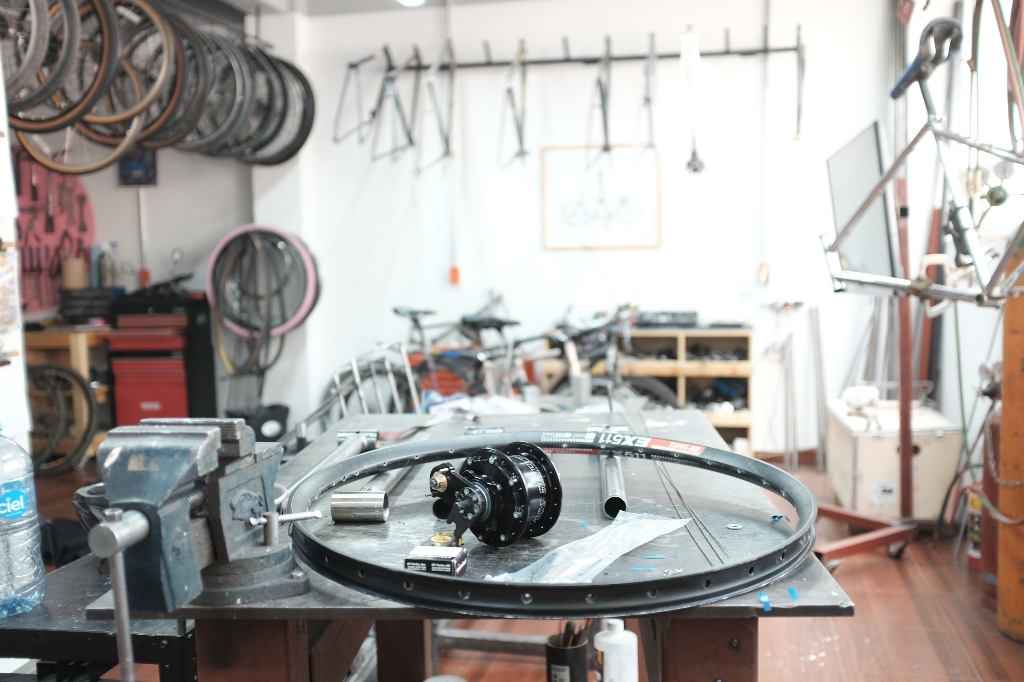
Wheel building at Básica Studio
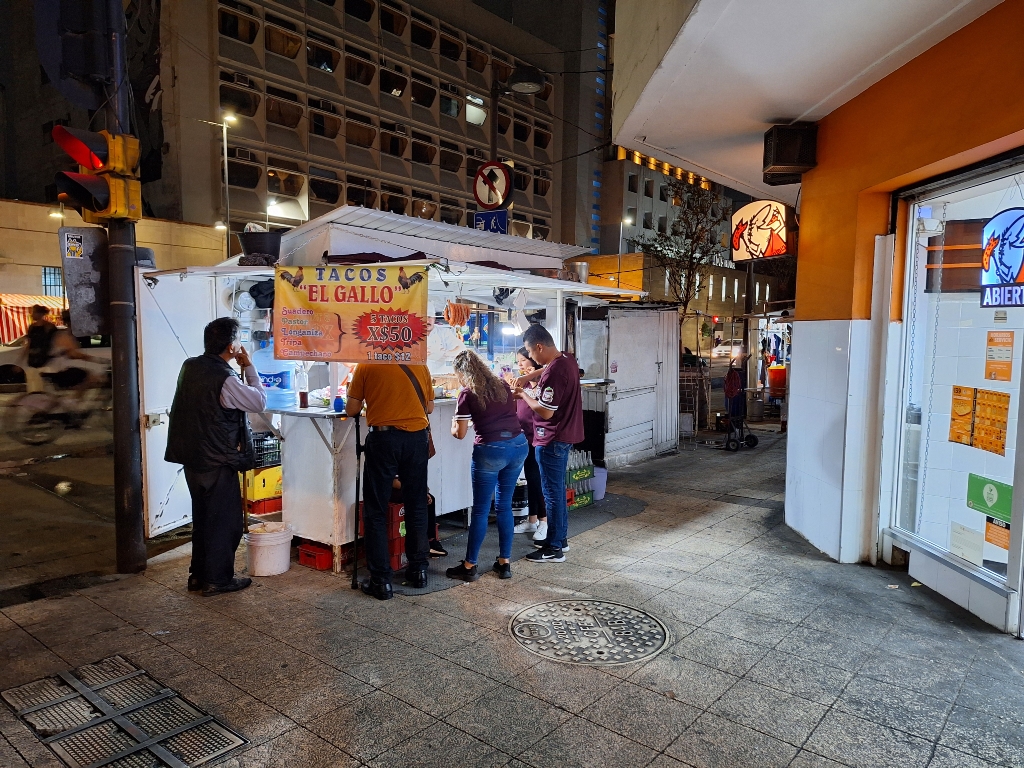
A favorite taco stand in CDMX
My first stop was to swing by the Básica Studio to drop off my frame so that they could straighten it out for me. I was surprised when they began clearing out a corner of the shop for me where I could work for the next few days. “Como en tu taller,” they told me. I had brought the tools I’d need to build a new rear wheel and figured I’d go do that in my hostel or in a park somewhere but having access to a fully stocked, professional workshop with some fun people made it all so much more pleasant. Juan, one of the guys working there, had taken a long cycling trip around Europe and on that trip had been confronted by some serious mechanical problems. He was unable to find a shop able or willing to promptly help him with a technical issue on his bike and was disappointed when so many told him, “we can make an appointment for you in six weeks.” He was determined that it shouldn’t be that way.
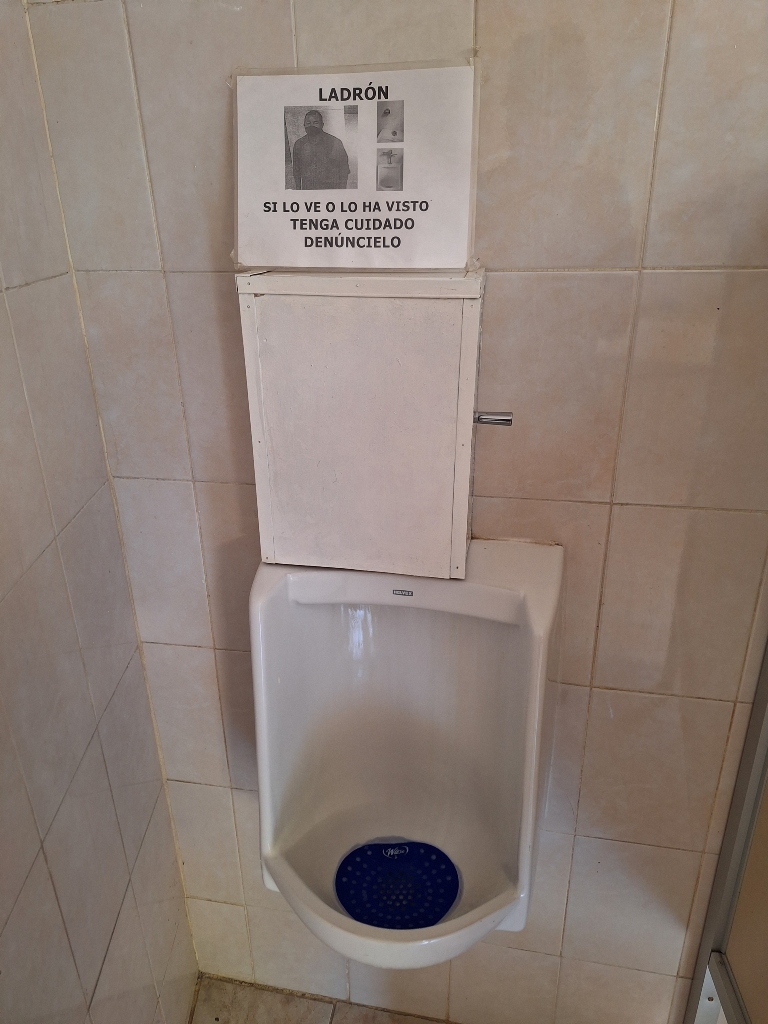
Someone stole the flush mechanism of the urinal at the Leon Trotsky museum. Why?
Bicycle wheels are amazingly elegant structures made out of a few lightweight parts, each with clear strengths and weaknesses, cleverly tensioned together in such a way that it utilizes those strengths to then make something that can haul you and all your stuff across continents. I spent a day or so taking apart my old wheel with plans to reuse the rim and then lacing in the new hub and spokes. The workshop was closed on the weekend so I took that time to go see the Leon Trotsky museum and the pre-Columbian pyramids at Teotihuacan. After a few days in Mexico City I said goodbye to the good people at Básica Studio and took the overnight bus back to San Cristobal. Once back in San Cristobal I picked up my new glasses and put the bike back together.
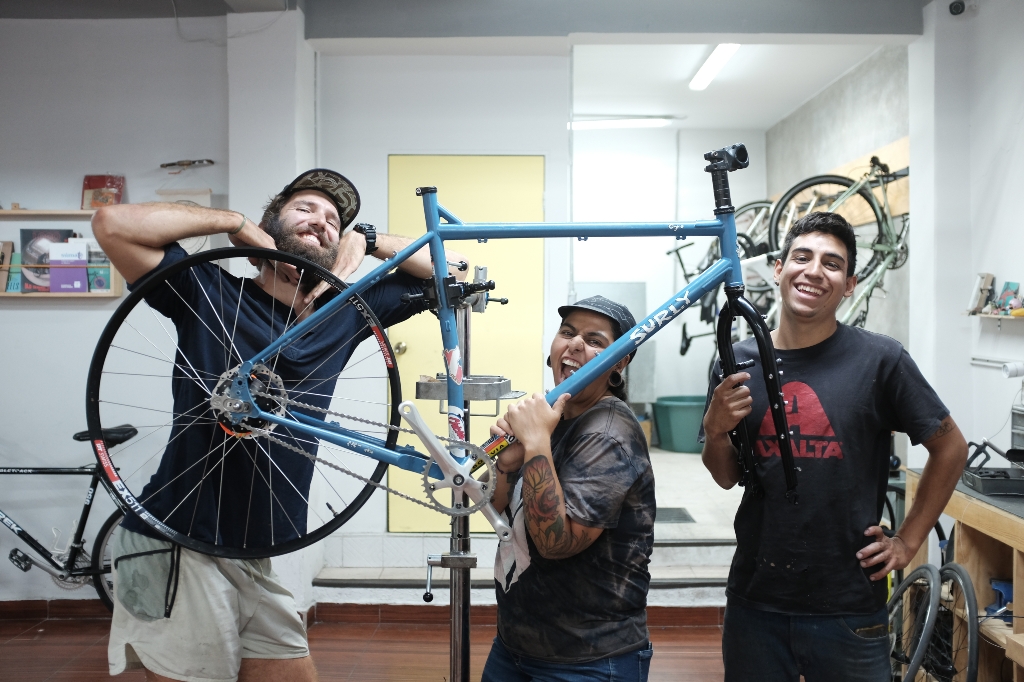
Straightened out and riding again thanks to Surly and the rad folks at Básica Studio
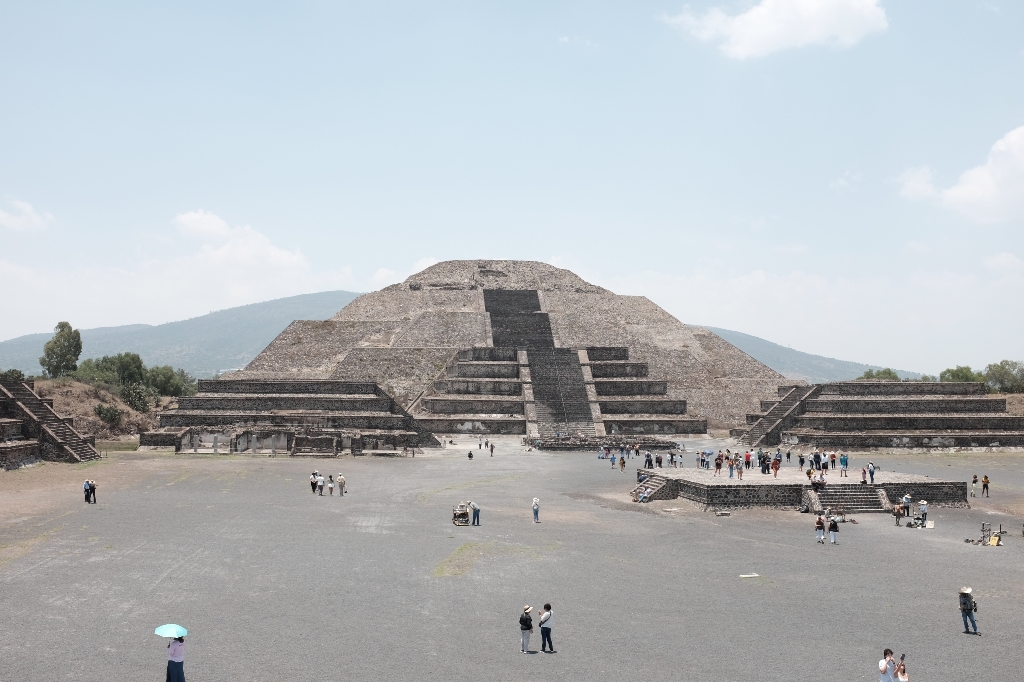
Teotihuacan pyramid
On the road again!
After about two and a half weeks spent working on the bike I was ready to leave San Cristobal de las Casas. Some people had warned me about cycling on election day so I decided to take that Sunday off and start on Monday. I went out to walk around and everything felt perfectly fine. Aside from most stores being closed, it felt like a normal day. Monday the 3rd of June I was riding once again! The day started off with a gradual uphill climb and then it was all down hill to Tuxtla where I camped at the fire department. The following day I rode, with legs cramping in the heat, to Jiquipilas where I was allowed to camp at the Protección Civil. This night, as with the one before, I began to wonder if maybe the trip had been enough. The normalcy of camping in weird places felt strange.
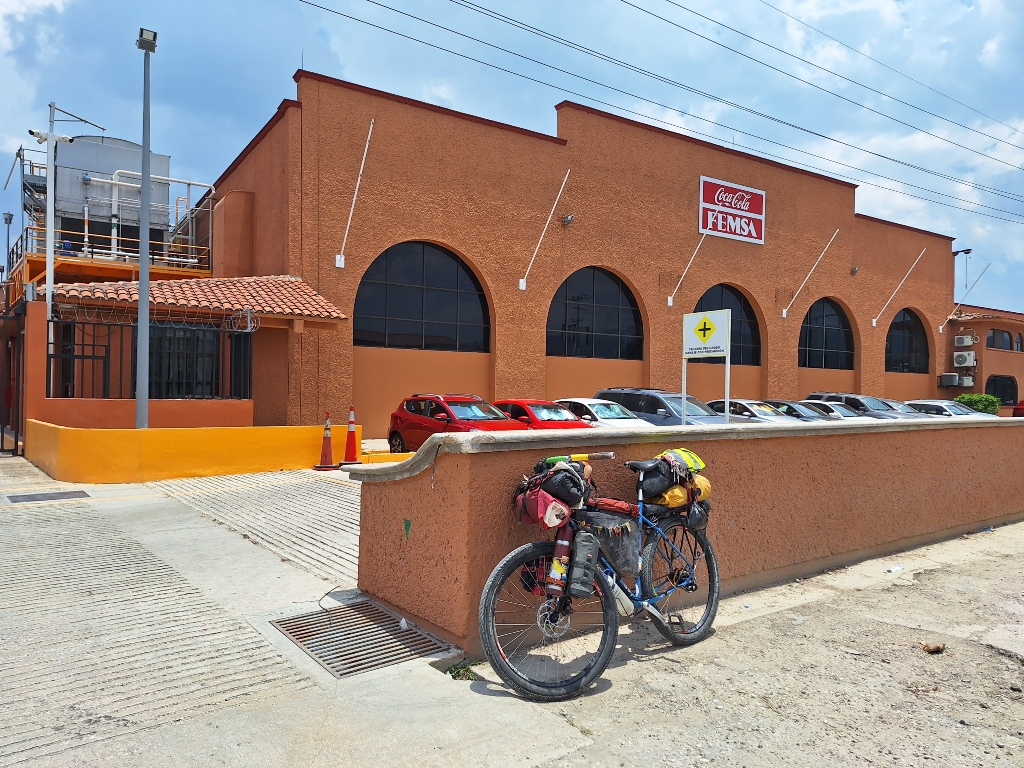
The contentious Coca-Cola plant in San Cristobal. The people here drink on average 2 liters of soda per person per day.
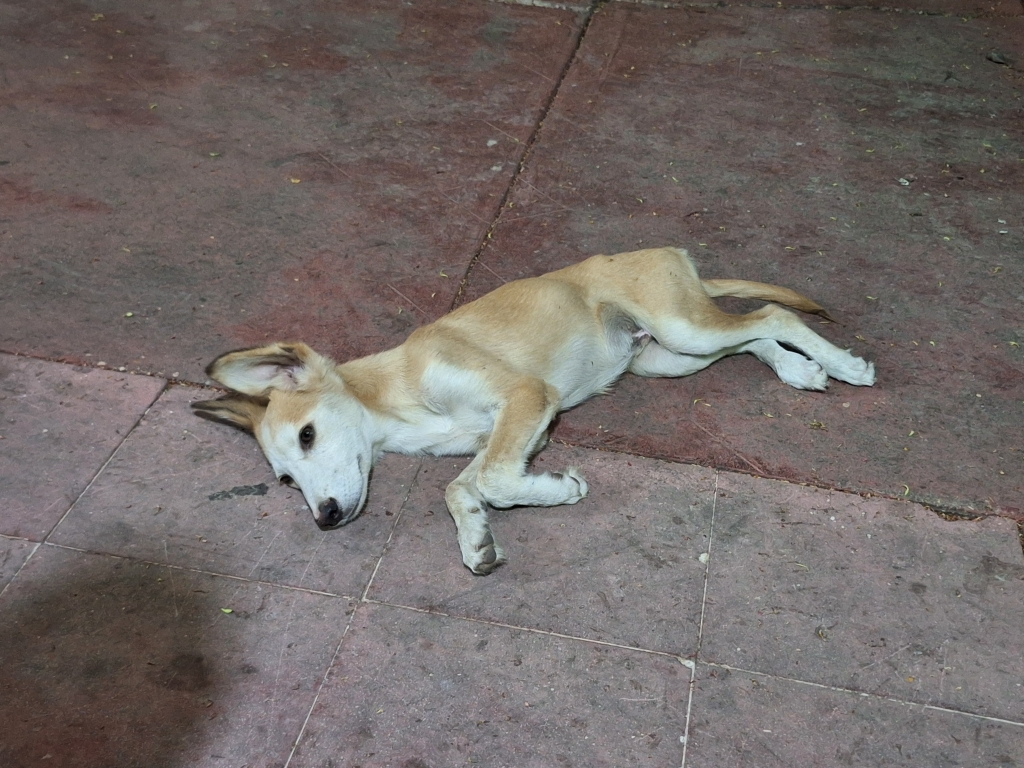
My buddy at Protección Civil in Jiquipilas
Along these straight stretches of road from the state of Chiapas to Oaxaca I saw many migrants walking along the road headed for the United States. A few times per day we’d stop to talk with each other. Most were families from Venezuela but I also talked to several guys from Cameroon and the Congo (DRC and ROC) and also a man from China. Towns that I passed through along this section, like San Pedro Tapanatepec, were full of migrants living in destitution. I passed through more military checkpoints along the road where the migrants were forced to take a detour through the woods; I’d be waived through the checkpoint without any actual checking and I’m certain the guys working there knew about the trail through the woods. For all of the hospitality I was shown on my ride through Mexico, there is no love shown to the migrants and theirs is a hard road.
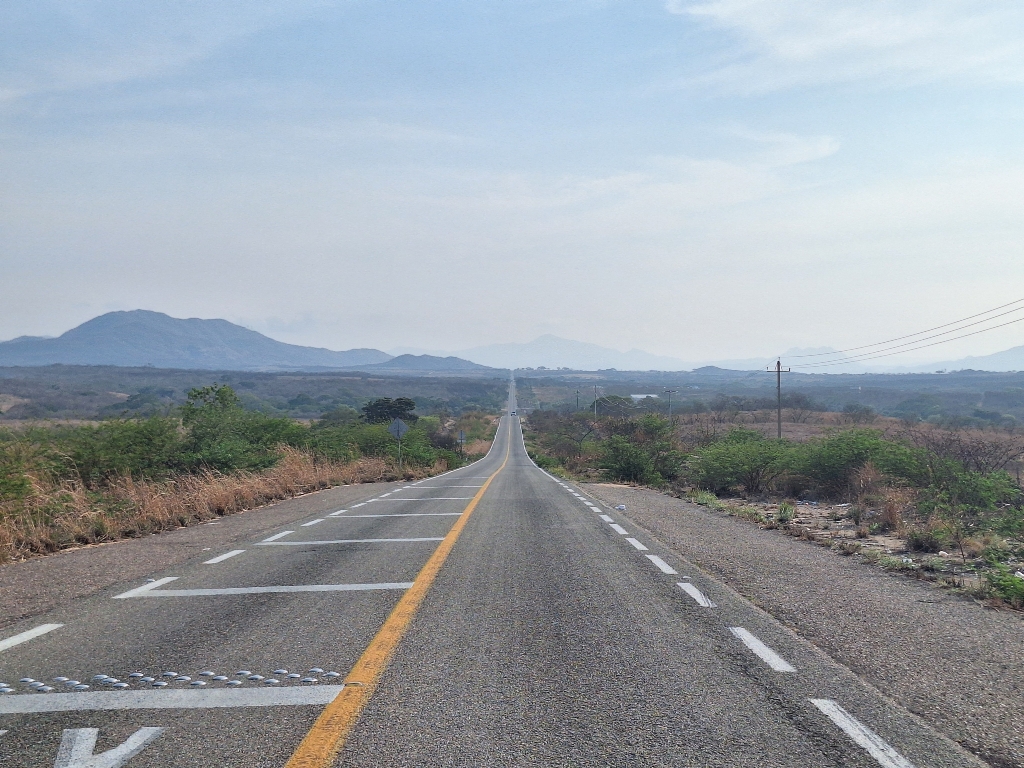
A quiet Chiapas stretch
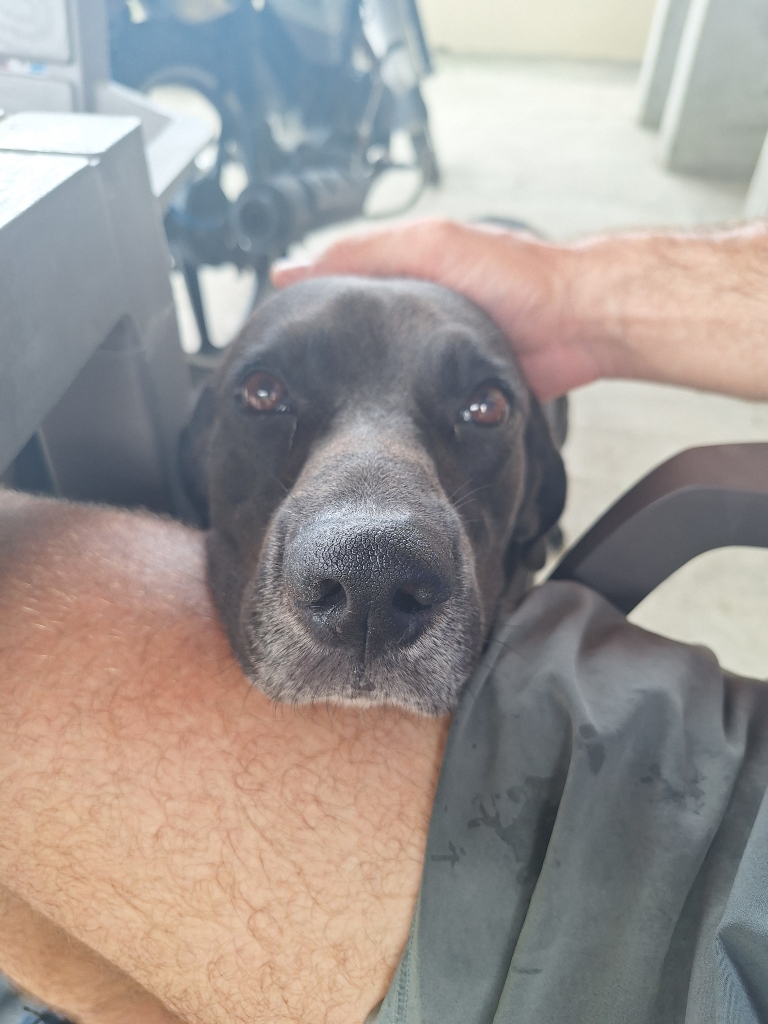
Hey there fella
Along the coast I stayed with a man and his sons. I avoid writing his name here because I’m not sure if his side-business is fully legal. Clean drinking water is an issue in most of Central America and maybe an even bigger problem in Mexico. In short, there’s a huge demand on water and it’s being used unsustainably. The guy where I was staying is a high school teacher but the teachers in Oaxaca state had been striking for the past month. The boys hadn’t been to school either. They had a well out front in their yard that they’d dug a few years earlier. Now with school out the boys and their dad were making money by pumping water out of the well and selling it to local residents. Cars would pull up every fifteen minutes or so with a 1000 liter tank in the bed that they charged about MXN100 to fill (US$ ~5). As we were filling another tank I asked the dad about the ins and outs of digging a well. What was the permitting process like to dig this? How big is the aquafir? Did you test the water quality? Whose water is it? But it quickly became clear that we weren’t exactly on the same page. “I don’t know, man, you just dig a well and pump water out!” We laughed about our different approaches to the situation. I took a rest day with the family and we did some maintenance work on a pump that had gone out. I camped in a mango grove on their property and ate the most mangos I’ve ever eaten. I’m guessing about 40 over the course of two days. My favorite variety, one I hadn’t tried before, is called mango piña. It smells like a pineapple and you squeeze the mango to soften up the inside, bite a small hole in the skin, and drink it; wonderful!
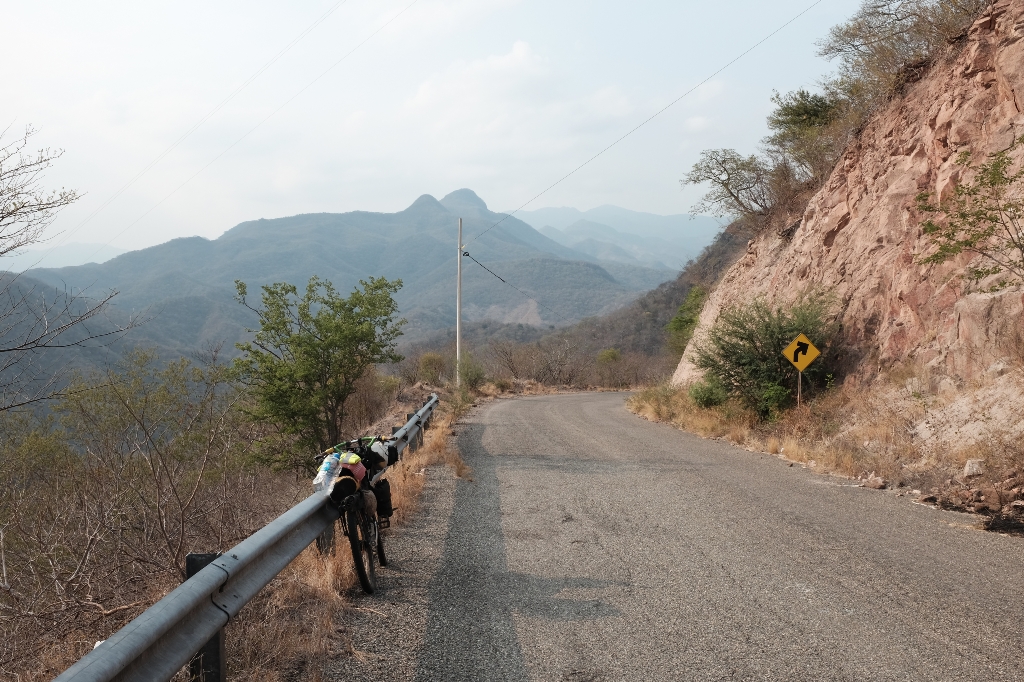
Some nice downhill parts
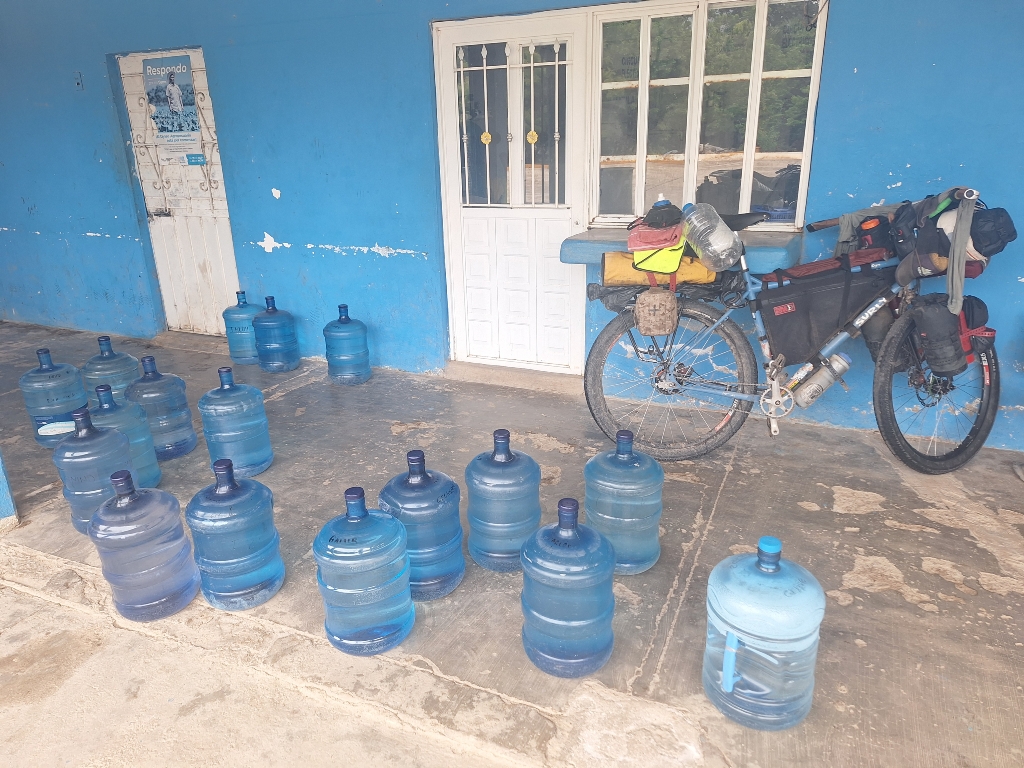
Rural families' water deliveries ready for pick up in Santa Isabel de la Reforma
After camping in the mango grove I carried on toward the west and turned onto the Trans-Mexico Sur trail (link). This section of the route was really quite difficult and the climbs were again really steep. It ended up being about five or six days of effort doing somewhere between 30 and 40 kilometers per day. Especially after this section I came to enjoy Mexico so much that I find it most appropriate to simply write about the encounters I’ve had with Mexicans along the way instead of chronologically listing every hill climbed and rain storm endured. So far it has been one of my favorite countries of the trip because the people have been so friendly and hospitable. As I was finishing another tough day through this rugged stretch I stopped in the town of Villa La Esperanza where I asked some guys if it was ok to camp out under the roof of the municipal office. No problem. In the morning Saul came to check on me to see how my night had been and invited me over to his house for a heavy breakfast of fried steak and tortillas with coffee. The night before I had drawn a pretty big crowd that watched me replace a spoke on my front wheel; the first to break on that wheel. As I got started up another climb that morning I rode past Peter and Rene who waived me over just to come and chat. They gave me a bunch of mangos and showed me around their construction site. They were finishing the roof on their house and were telling me about the concrete/aggregate mixture ratios they were using.

I took a break and sat in the river to cool off
One hot day I took a break under a bridge, made myself a cup of coffee, and did some reading and generally revelled in the idea that no one knew exactly where I was in this moment.
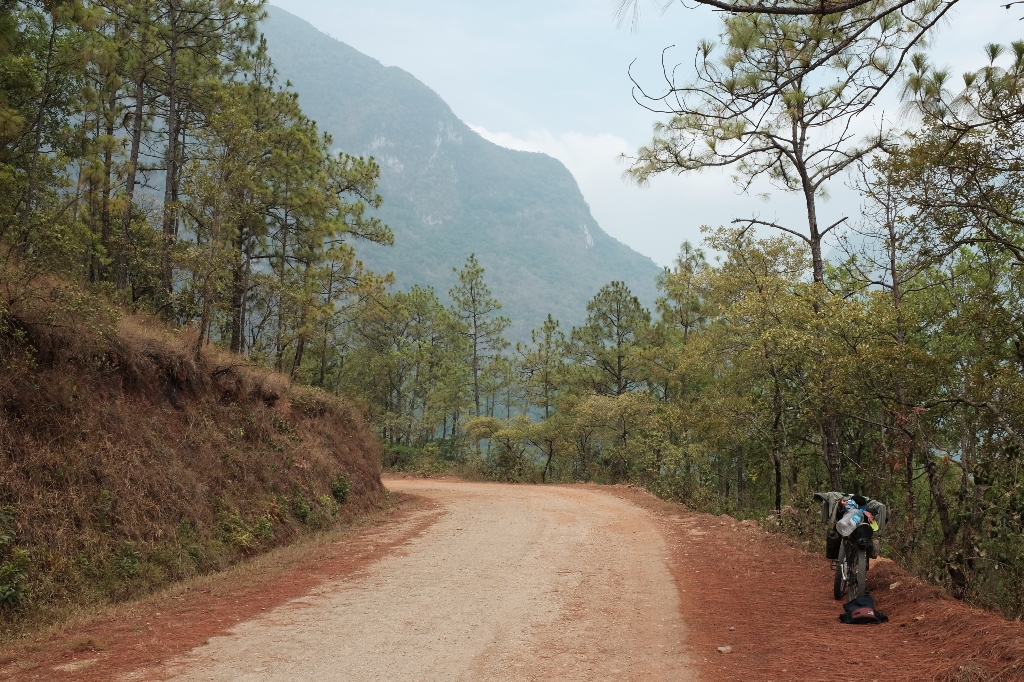
Pretty countryside...

... but also difficult
Eventually, after a few days, my trail exited onto a main road with gentler grades and I rode to Hierve El Agua, a fresh water spring that is rich in calcium carbonate, which causes the water to deposit minerals on the cliff face over time leaving what looks like a big waterfall made of rock. I quickly went to see the formations before the park closed and then camped in the nearby town. The following morning there was one more climb to go before descending down into a flat valley toward Oaxaca city. Having spent the past few days struggling to do 30 kilometers per day, I was now easily doing about 30 per hour going slightly downhill with a strong tailwind. I could get used to this! I stopped at a roadside restaurant and drinks stand for a coconut water and some people came up to chat and ask me where I was from. There was so much going on. A preacher named Ramon from Henderson, Nevada said a prayer for me with his family. The folks selling food were curious to hear about my trip. I rode on toward Tule to see about a big tree.
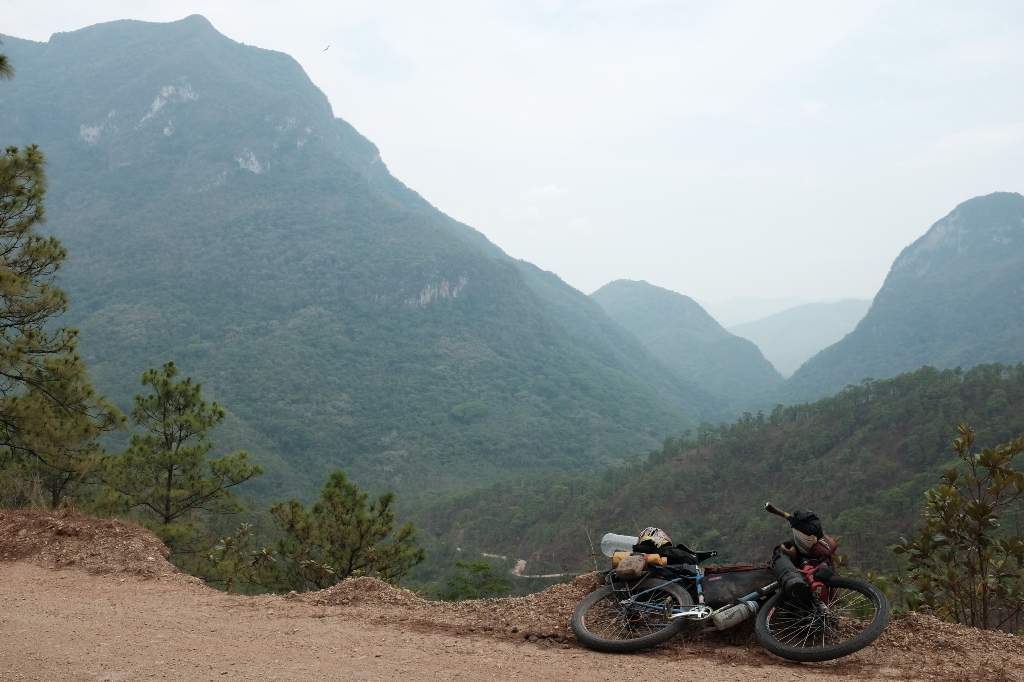
Already wishing I had lower gearing
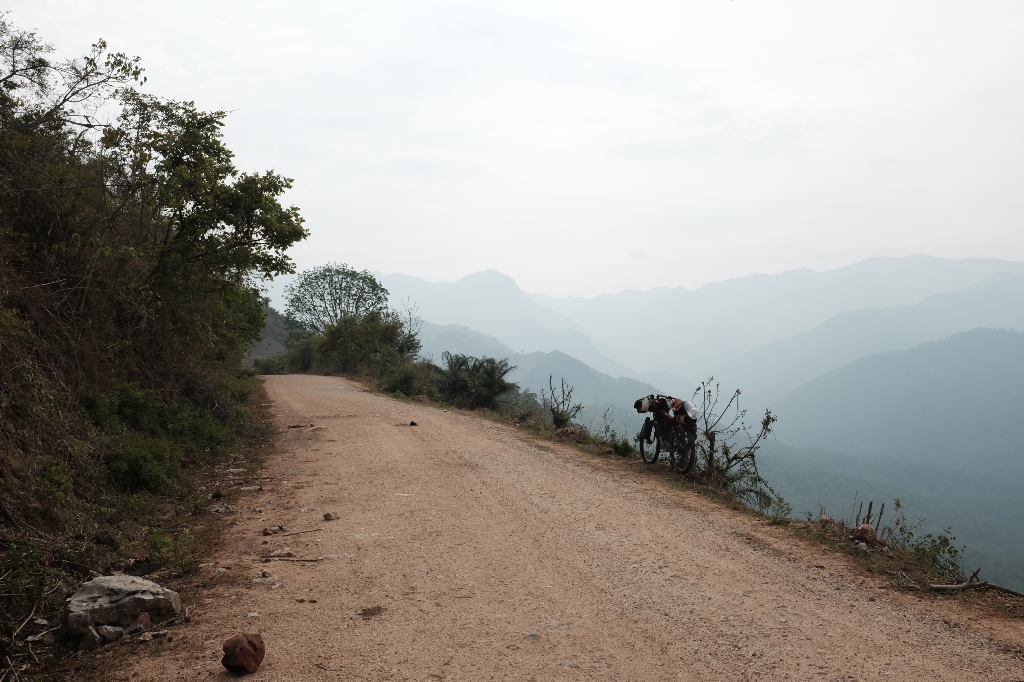
Enjoying a little flat stretch with a view
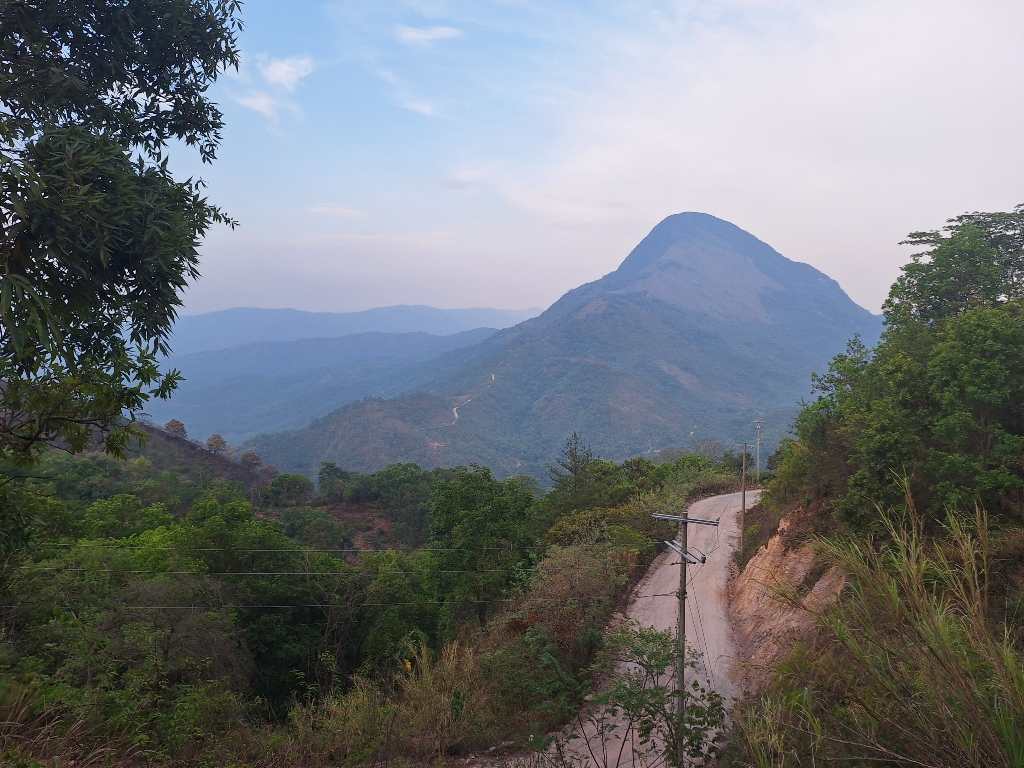
Looking back on the road I took

The view from the church campsite in Santiago Ixcuintepec thanks to Padre Evencio
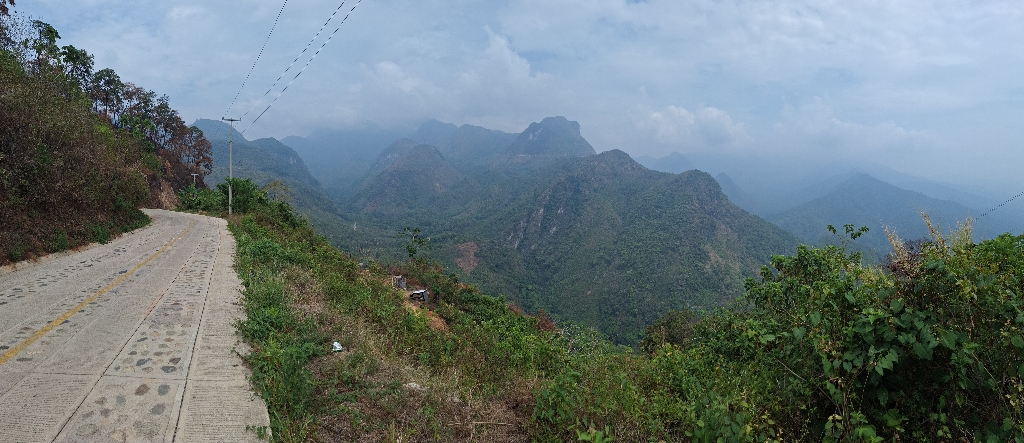
A paved section
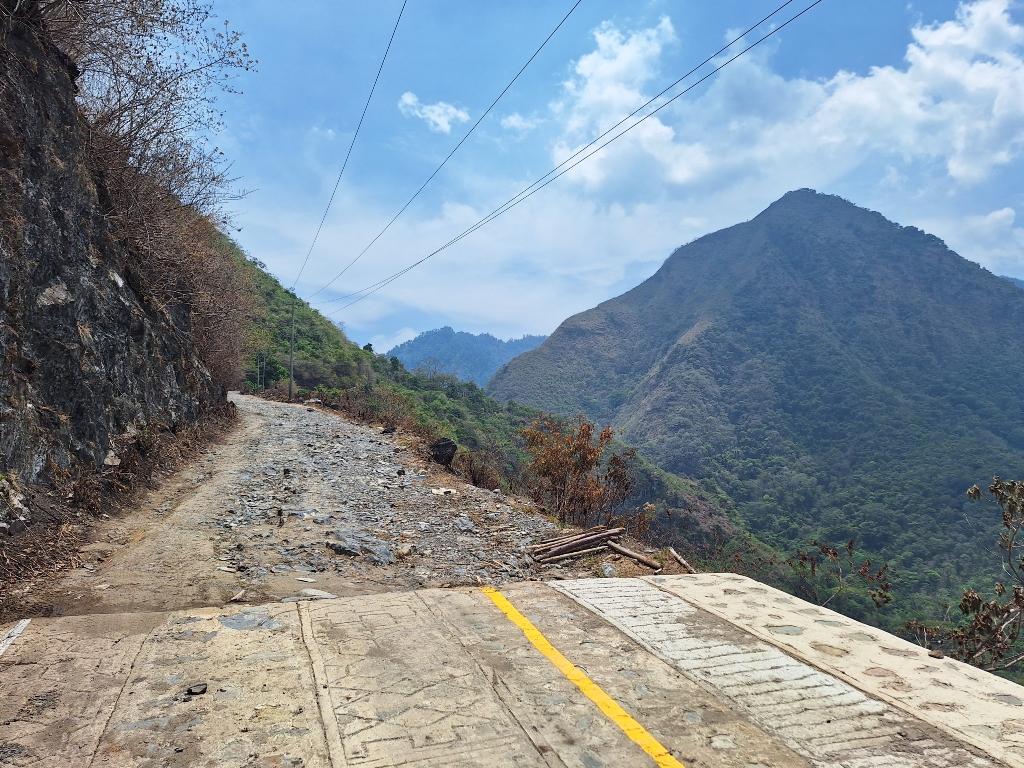
...but let's not let it get too easy!
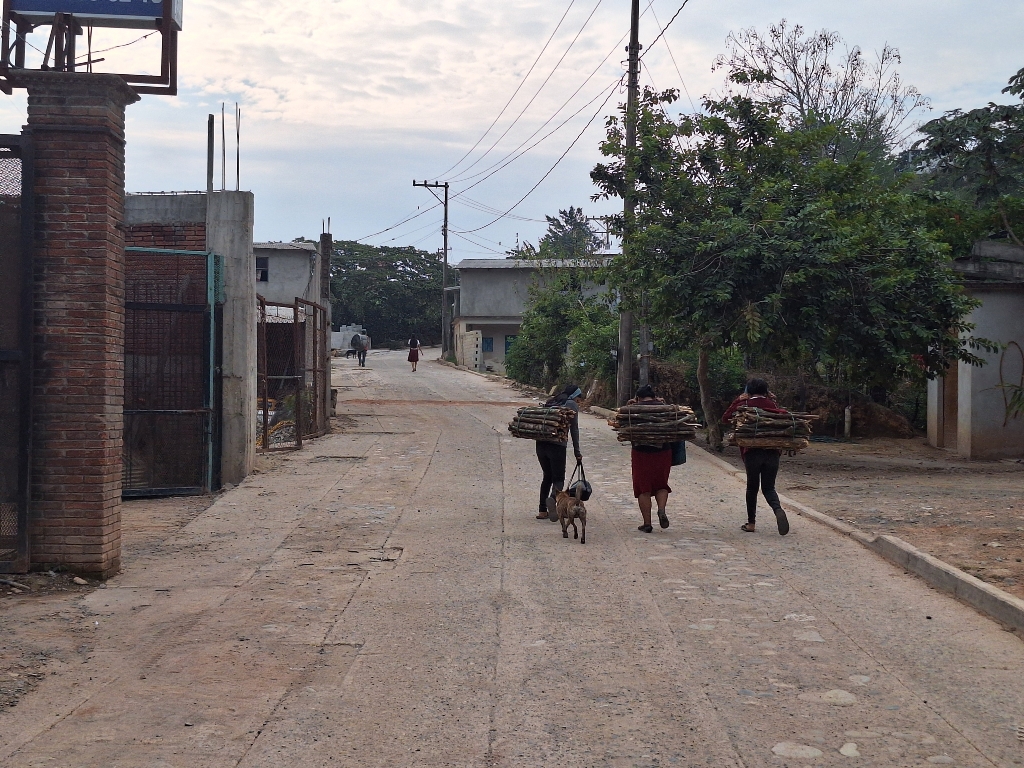
Ladies carrying firewood using a sling wrapped around their foreheads
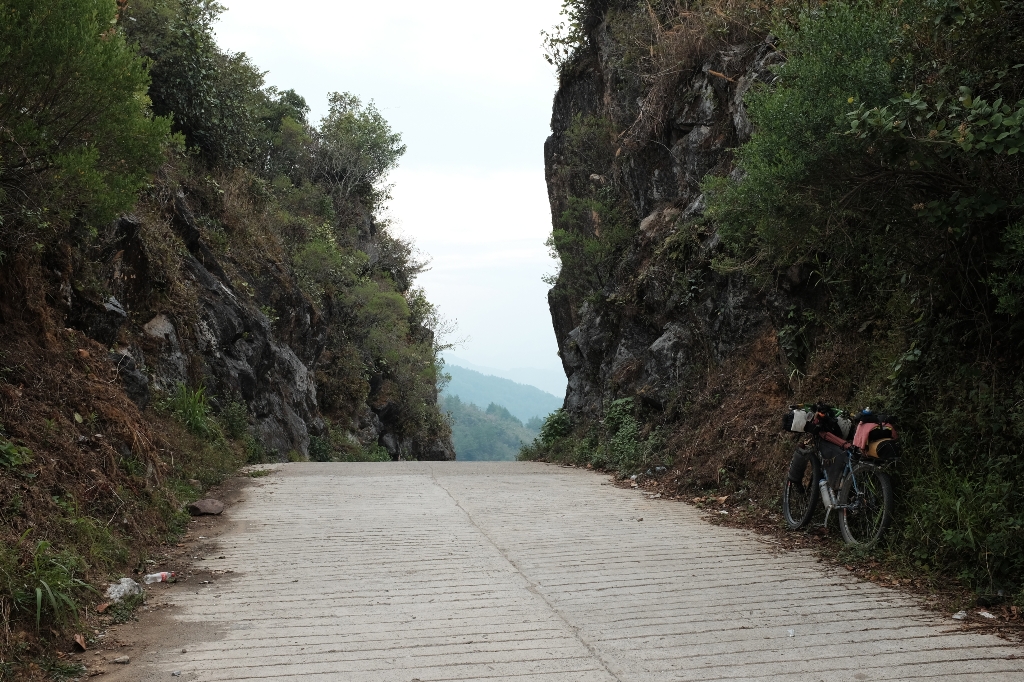
A very clear high point; cresting a pass
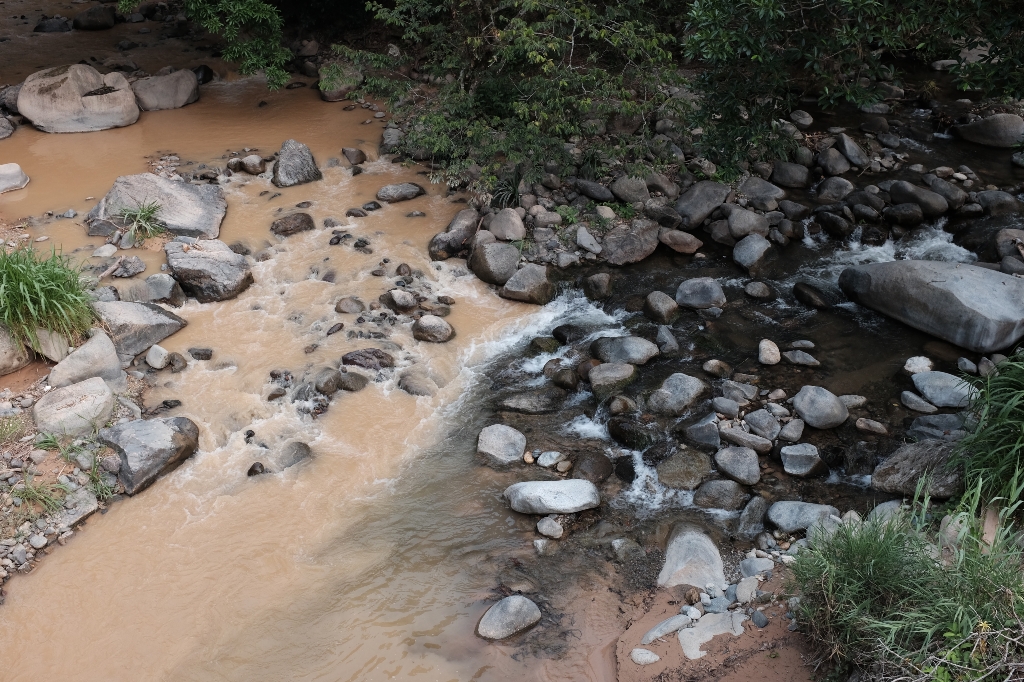
The beautiful confluence of two rivers
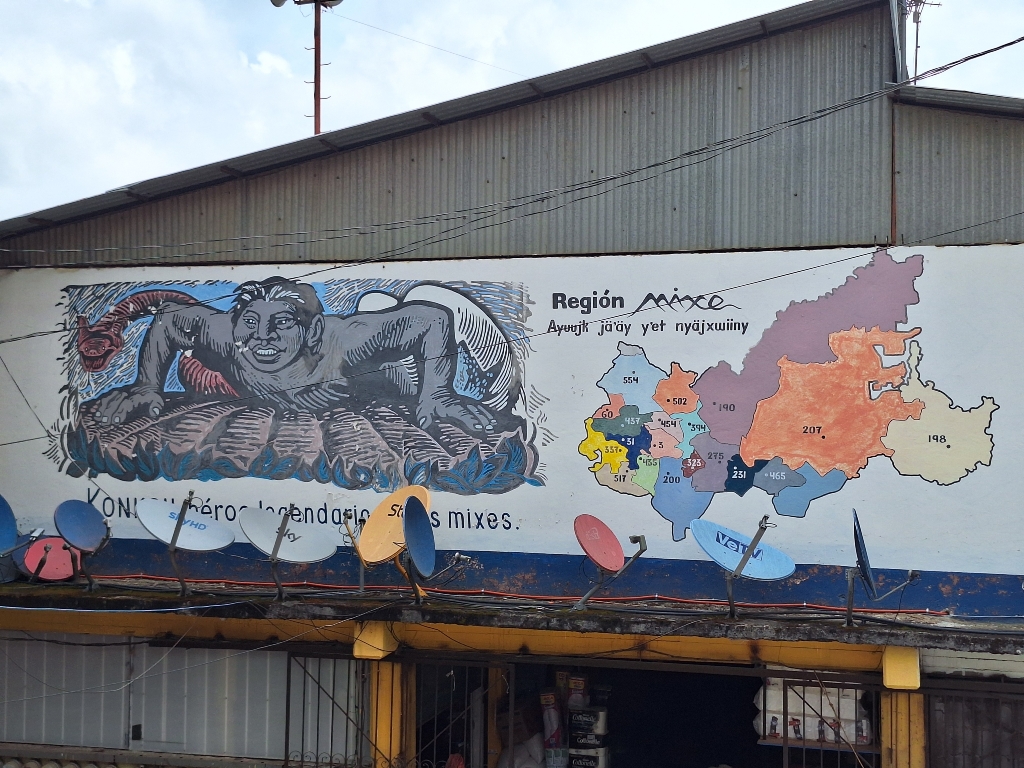
A map of the indigenous Mixe lands
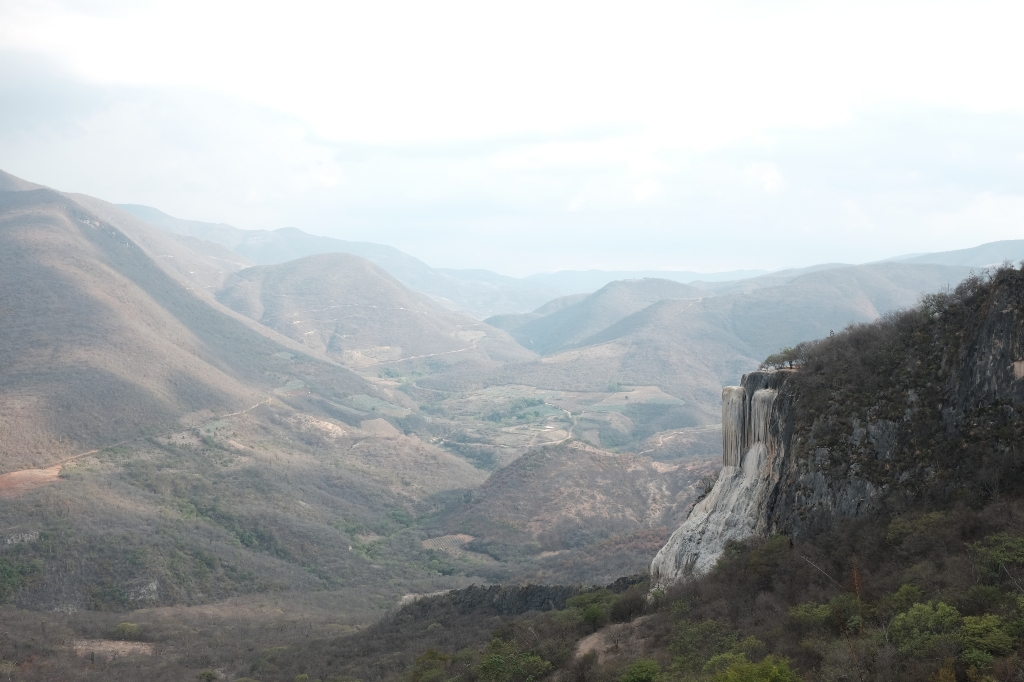
Hierve El Agua

A nice little break
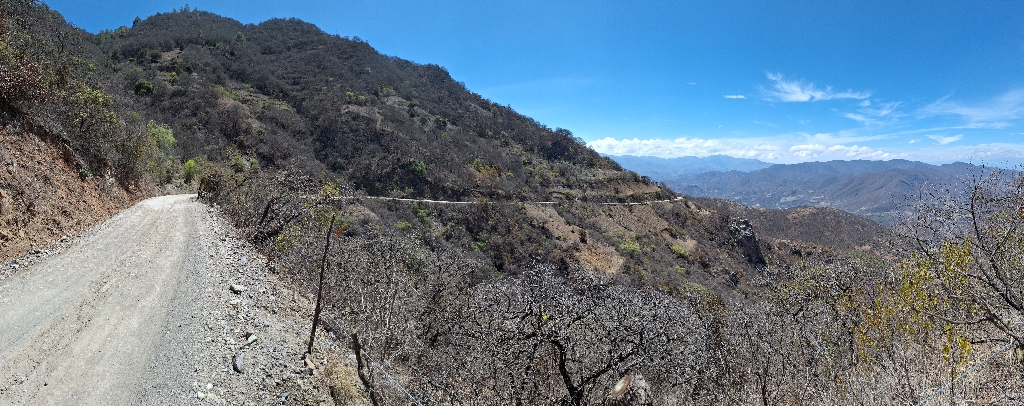
Looking back on the last climb before a few days' rest
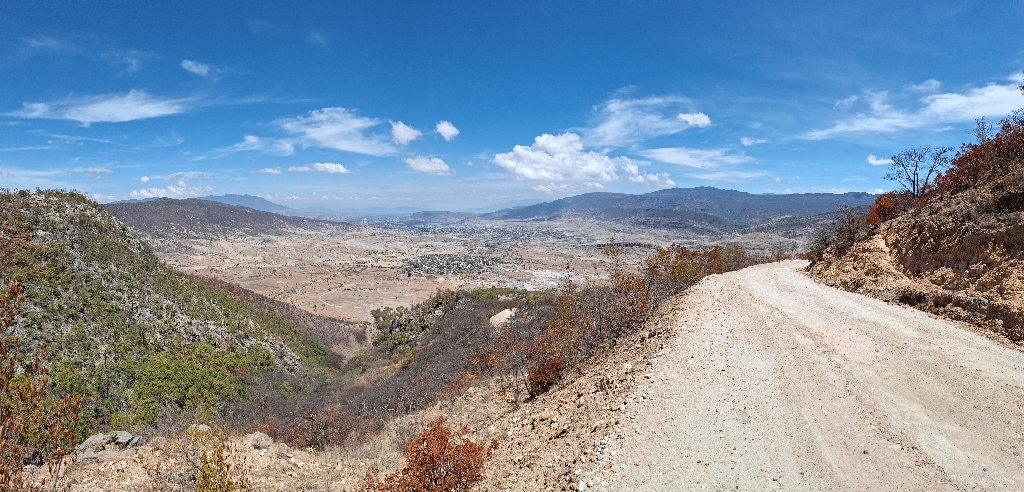
And now downhill to Oaxaca

Past the mezcal farms and distilleries
A few years ago I had heard about a big, old tree in the town of Tule and wanted to go see it for myself. It’s the “stoutest” trunked tree in the world with a 14 meter diameter. There’s nothing quite like an old, old tree to make ya think and this one’s a big one! I saw various age estimates with a wide range but most seemed to put it somewhere around 2,000 years old. At the tree a man named Oliver and his family, visiting from Los Angeles, came up and asked me about my trip. I spent a few days in Oaxaca city where I met some really nice people and together we took some food and mezcal tours and watched some Euro Cup football. After a few days there I hit the road again headed for Puebla.
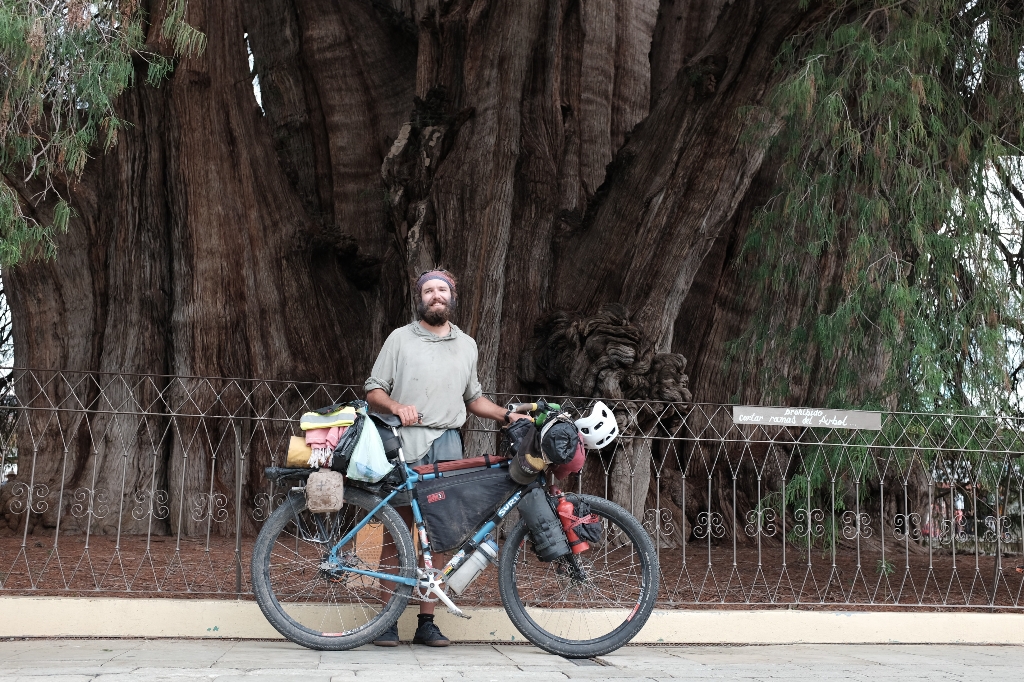
Me and the Árbol del Tule, a gigantic Montezuma cypress with a 14 meter trunk diameter (!)
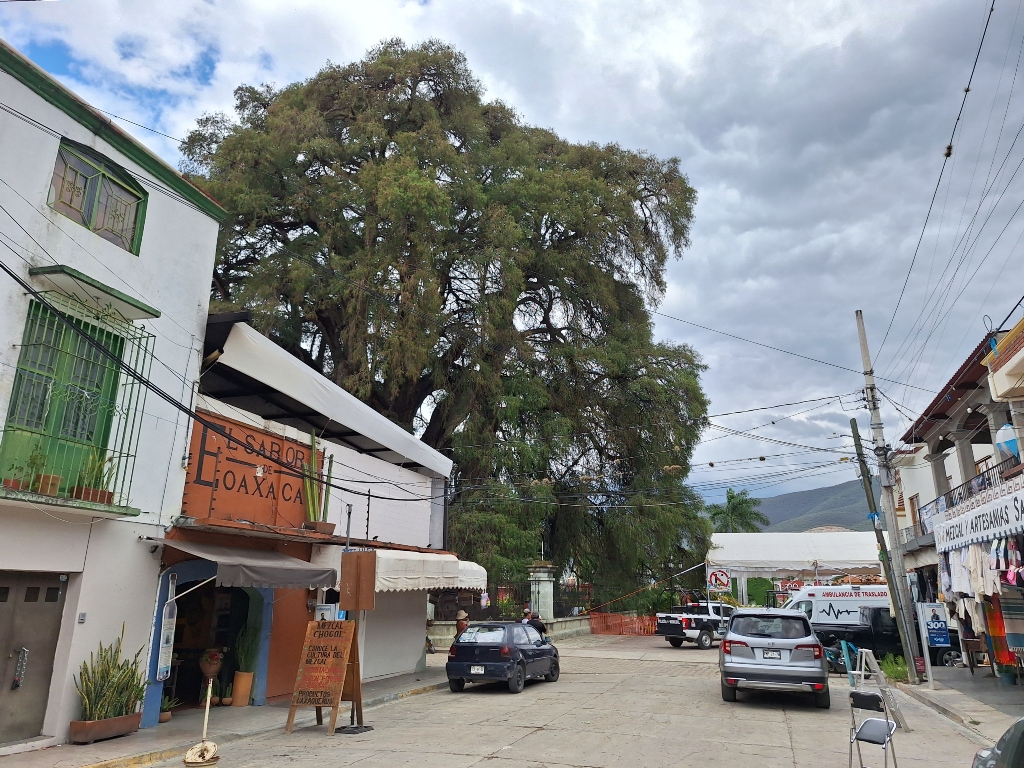
Not a particularly tall tree but rather corpulent
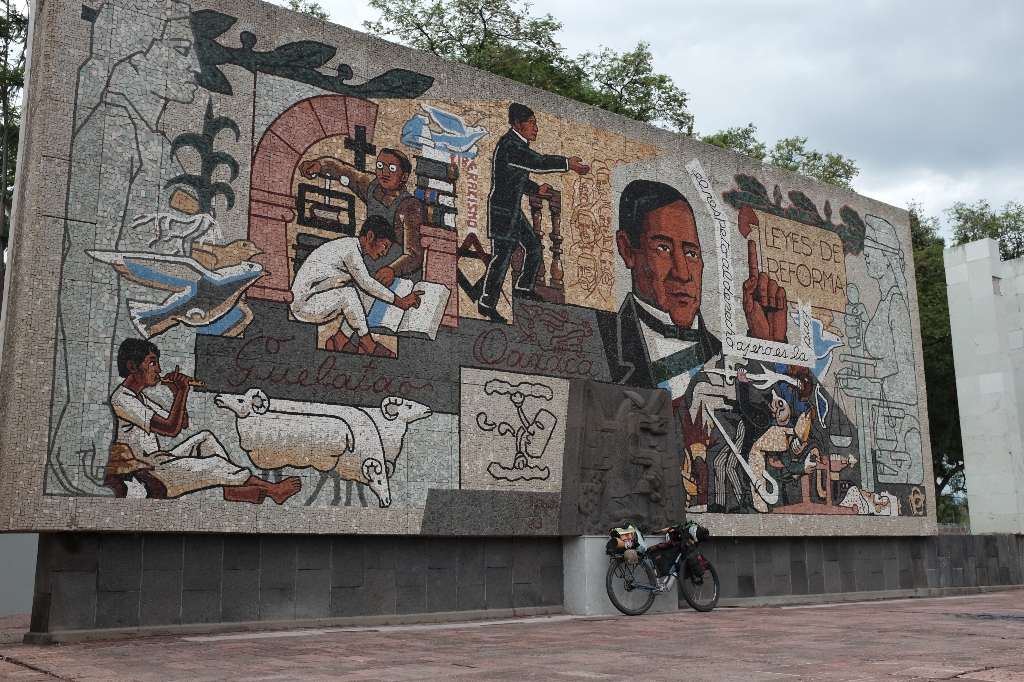
A neat mosaic entering Oaxaca city

An unfortunately all too common bulletin board of missing persons
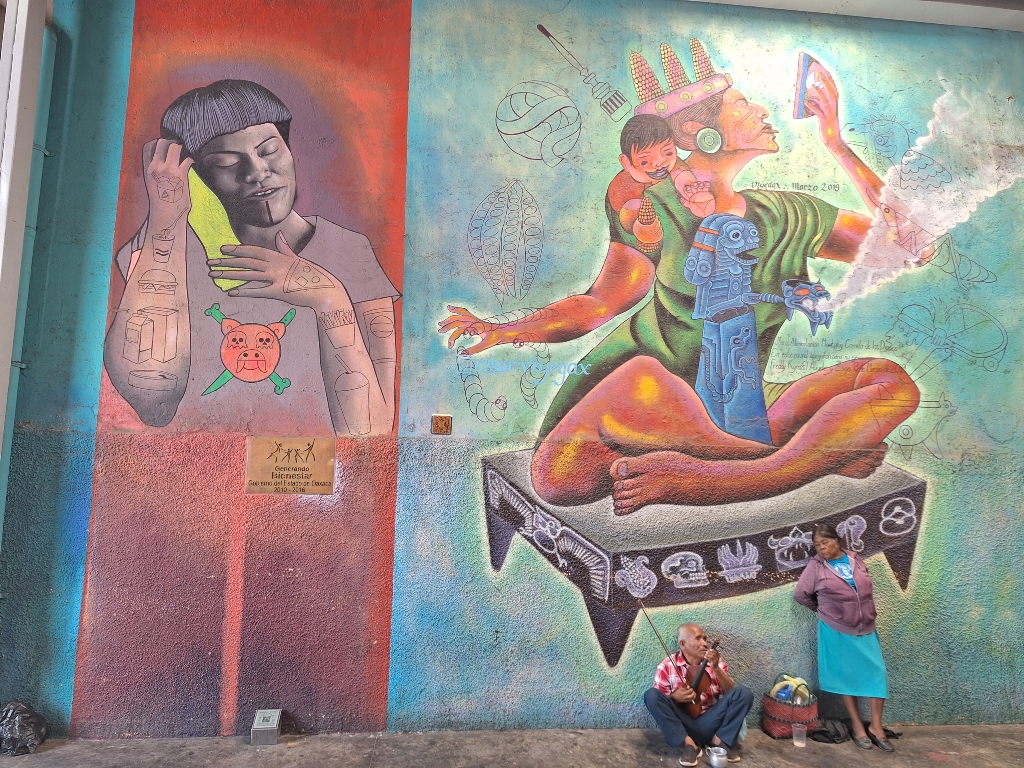
A mural about kids being spoiled by modern ways and foods

A mural of the mole boss at the Oaxaca market
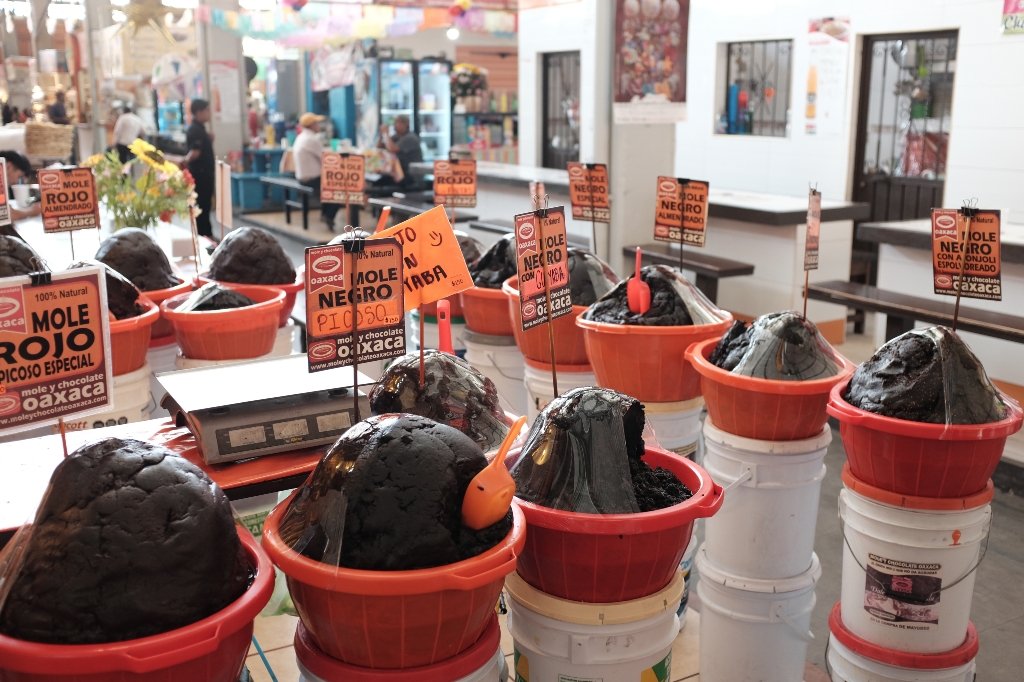
Mole pastes for sale
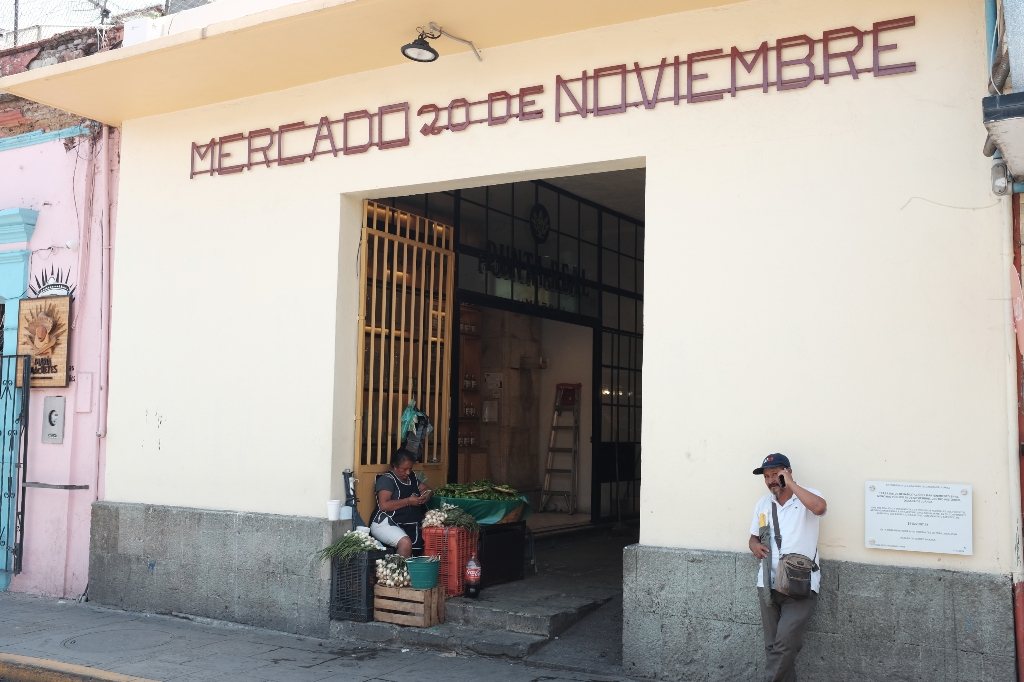
Outside of the market
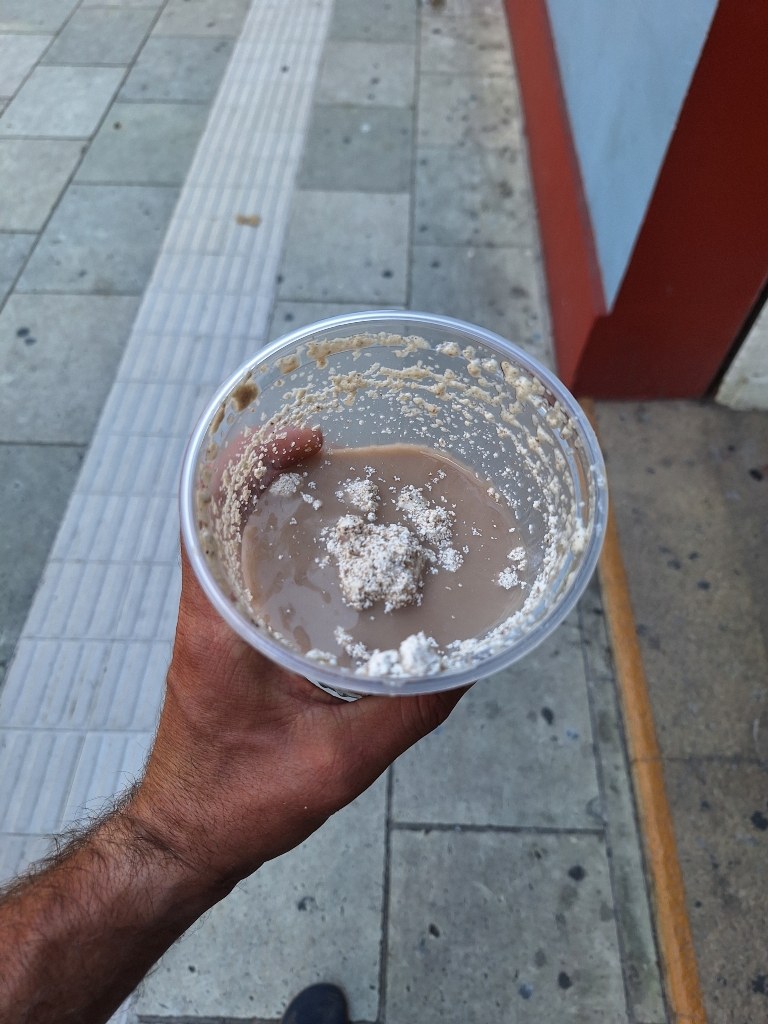
Tejate, la bebida de dioses. The white stuff is fat from the cacao. Not too sweet, very good!
The week or so that it took me to ride from Oaxaca to Puebla had a lot of afternoon thunderstorms. I’m not sure if all of the rain was just the rainy season starting or a hurricane out over the Gulf of Mexico. Most of the wonderful interactions on this stretch were brought about by having to seek shelter from the storm. Timing was perfect when I showed up at Francisco’s shop in San Pablo Huitzo. I could snack a bit, get out of the rain, and chat. Francisco had spent many years living in Chicago and told me about his time there. Our conversation was half English and half Spanish. That night I cycled until late and found and unfinished roadside shrine to sleep in. It wasn’t an ideal campsite but I was dry. I slept poorly on account of the many trucks passing in the night. Mexico’s landscape really opened up on this stretch into something I hadn’t seen in a long while. Passes would crest and reveal big, wide vistas of the desert. Many days I’d find myself cycling a long, quiet stretch with a rainstorm a few kilometers off to my side. Each time I thought I’d be able to outrun it. “I’ve got a strong tailwind and I’m flying.” Howling from excitement, nothing could catch me but eventually the rain always did.

Graffiti in support of the Mapuche people of southern Chile; a long way away

I stopped at an Oxxo (i.e. Mexican 7-11) in Tamazulápam for milk and cookies and to have a look at the map. I think it was about an hour before sunset and my progress had slowed for the day. My map showed a small football field in the next town and I figured I’d go check that out. I was climbing uphill in the rain when a pick-up truck asked me if I needed a ride. I asked him where he was going and he told me Huajuapan, which had been my original goal for that day. We tossed my bike in the bed and off we went. After chatting for a bit Luis asked me where I’d stay in the city and I told him I’d probably go ask at the fire department. He told me I could also camp in his garage. We drove to his house and had dinner with his mother and we spent the evening chatting. After a fun evening he told me he also had a spare bed I could use and he’d feel weird about letting a guest sleep in the garage. In the morning, we ran some errands for the family’s rotisserie chicken restaurant and I got a really late start around 2 PM. I learned that he’d been having a tough time lately and that it had done him a lot of good to help someone else. He taught me the phrase “me nacio.”
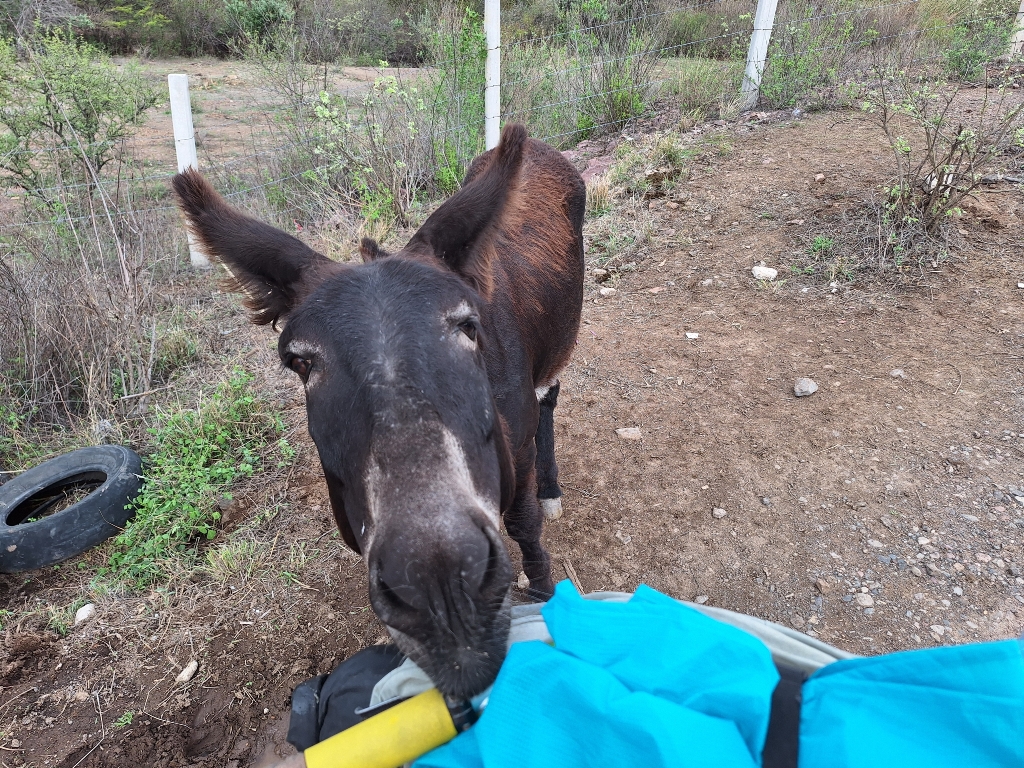
A friendly burro

My municipal office campsite in Santiago Miltepec
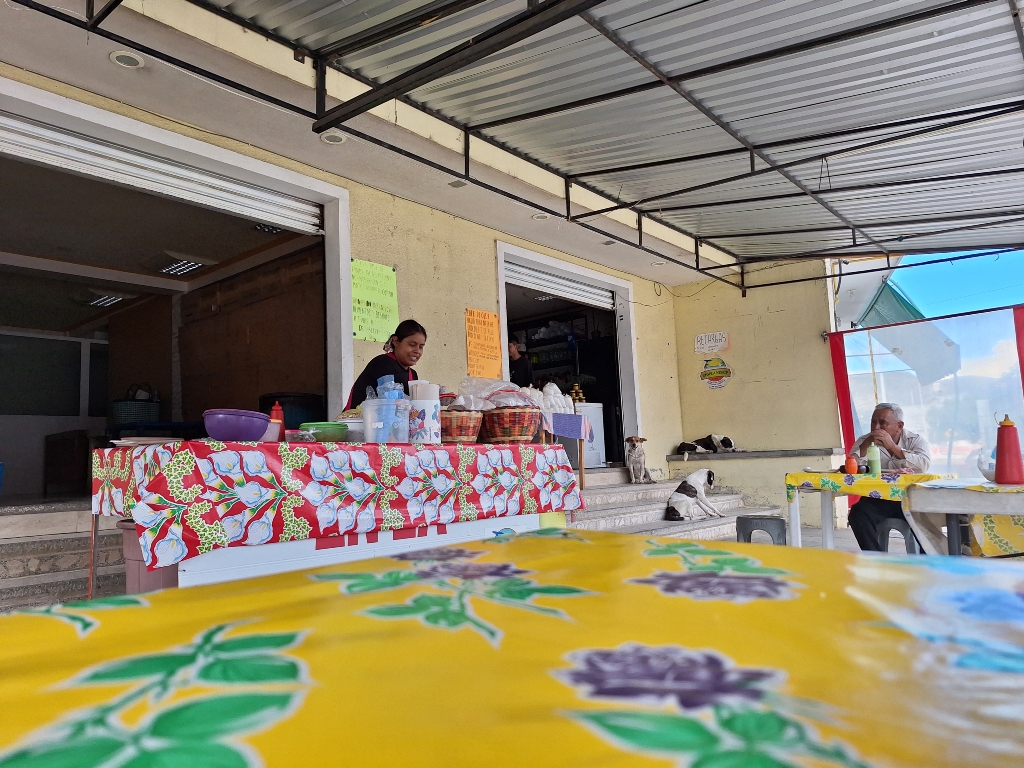
Stopping for tacos in Zapotitlán
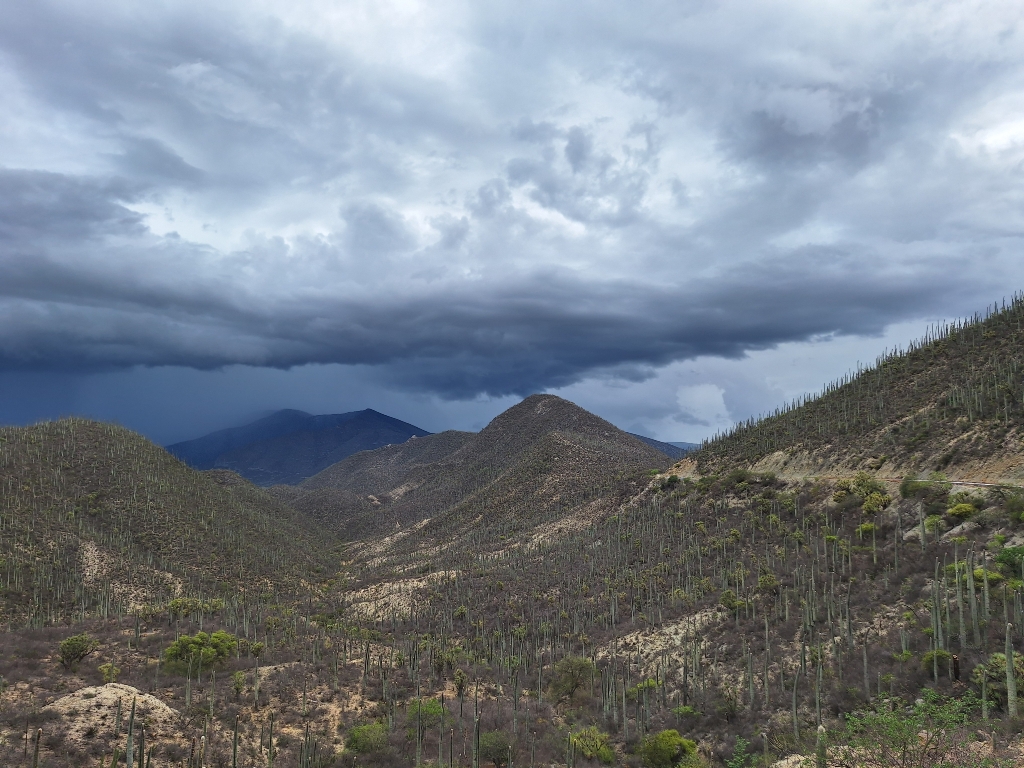
Seeing rain off in the distance
This region of Mexico is also known for its cuisine and some of my favorite dishes have been the moles (i.e. heavily spiced sauces served with chicken and rice). I’ll usually pedal until I’m hungry and happen upon a busy looking roadside place. It became really apparent on this stretch that when I’d sit down in a crowded restaurant and someone came to take my order that the whole place would quiet down to listen to me speak. I found it quite funny. They were these really short moments of, I imagine, people thinking “get a load of this guy,” I order, and then “ok, whatever” as everything quickly returned to normal.

Sleeping in Christian's family's shrine in San Antonio Tlexcala
A day later the afternoon rain had me waiting in a bus stop in the town of San Antonio Tlexcala but this time it wasn’t abating. I checked for my usual haunts but couldn’t find anything so I started walking toward the main square when a car pulled and asked me what was up, he’d seen me waiting in the bus stop for a while. I explained what I was up to and he told me to follow him in his car. Christian took me to his family’s house and introduced me and told me I could camp in their shrine. I slept well and in the morning we chatted a bit over coffee before I hit the road. Christian works in a nearby marble mine and showed me some of what they make with the material.

I gave him some mole chicken and he didn't mind the spice
As I was slowly climbing out of town a local cyclist named Alfonso pulled up alongside me for a chat. At the next convenient turn he conducted an impromptu interview. It happens quite often that you’re slowly pedaling up a hill and a car pulls up alongside, windows down, phones out, “DE DONDE VIENES??!!!” People are so excited. It’s a bit alarming at first and some days you’re more affable than others but I shudder to think of the number of TikTok videos out there featuring some grumpy, bearded, bicycling hermit thrust into the spotlight. After this final pass it was downhill into a busy, densely populated corridor that stretched all the way to Puebla.
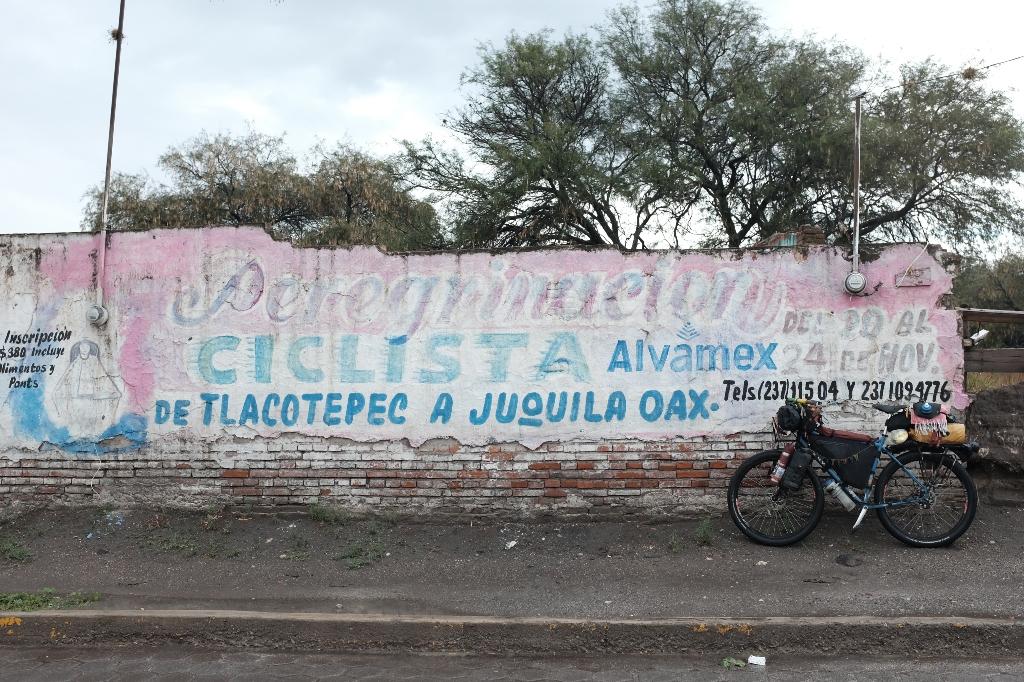
Join the peregrination for only 380 pesos!
The riding wasn’t anything special but I met some more nice people along the way. I stopped to escape some rain in a small shop and met two ladies working there, Carolina and Mariella who sent me on my way with a drink, some cans of tuna, and some crackers. That night I made it to the town of Tecamachalco and was waiting outside of the church for mass to finish so that I could ask to camp on the church’s property. As I was waiting, a man named Carlos and his friend walked up to me and asked about my trip. They gave me a drink and some snacks. Carlos had just read a travel book by a Mexican cyclist and was inspired by the kindness and hospitality of strangers that he’d read about. Carlos arranged a hotel room for me at his cousin’s hotel and I spent the evening listening to music, eating a Snickers, and reading.
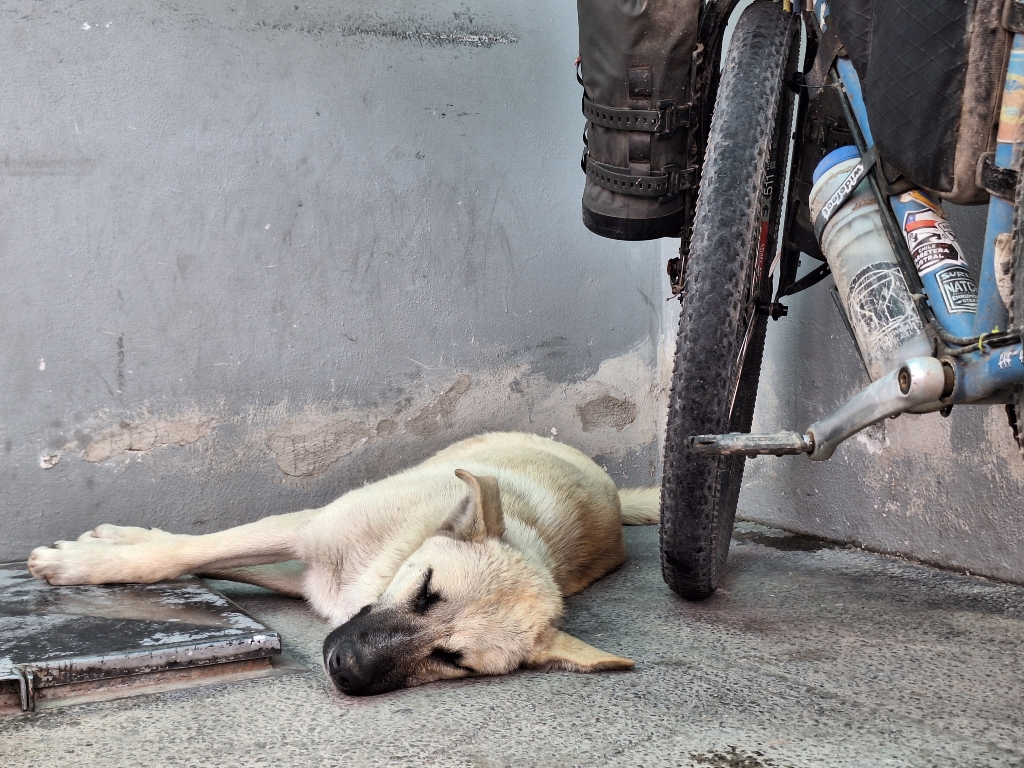
Waiting out some rain together at a gas station
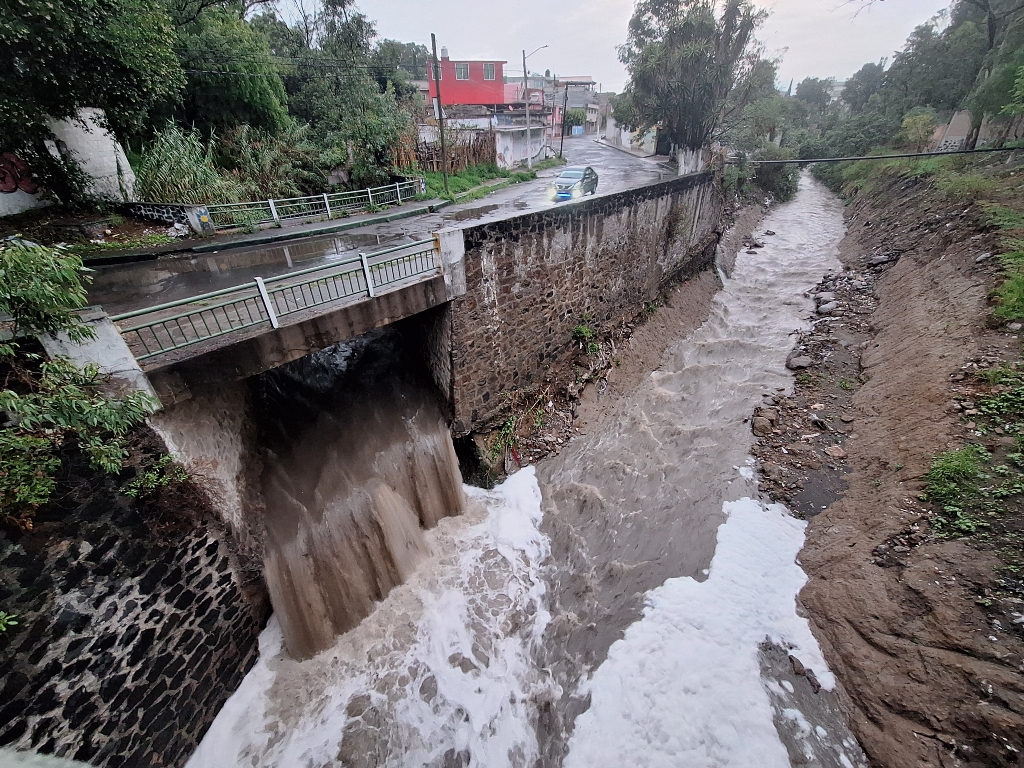
When it does rain there's too much water
From the town of Tecamachalco it was one more rainy day to Puebla where I took a few rest days. Riding into the city at the end of a long, rainy day was a mess. There’s not enough water but then when it rains there’s too much water as the drainage systems are inundated and the streets become covered in giant pools of smelly water. I took a bed at the first hostel I found. I think I was the only guy staying there; it was a bit weird. I ate some great tacos in Puebla and noticed that there also doesn’t seem to be much of a correlation between cost and quality. Sometimes you’ll find 5 tacos for 50 pesos and those were really good. Other times it’ll be one for 30 and they’re mediocre. It seems that the prices fluctuate mostly based on location. Also, with things like drinks and food I’m used to a larger volume products having a lower unit cost. If you buy more then you “save” a bit of money, but here it seems to be the opposite. With stuff like beer they’ll have a normal can size (330 milliliters), a bigger can size (473 ml) and the really big, “I’m just gonna have one beer!” size (710 ml), but the can with the most beer per peso is the smallest one, followed by the medium one, followed by the biggest one in last place offering the least amount of beer per peso. I tried asking the guy working in an Oxxo but he just looked at me and said, “yeah but it’s more beer…”

Some great tacos in Puebla

A strange cultural difference, the hidden cashier

A cool mosaic at a phosphorite mining company outside of Puebla
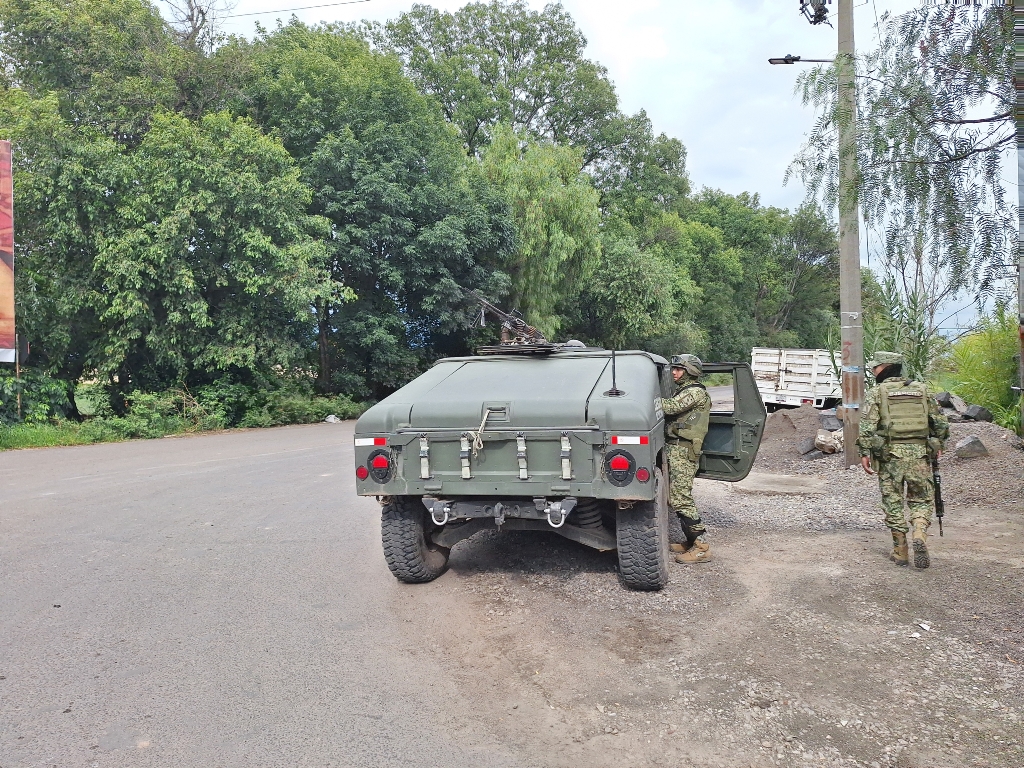
The military driving around, a common sight
From Puebla I rode to Natívitas where I had planned to stay with Lenin whom I had contacted via Warmshowers. Unfortunately, by the time I was in the area he was out of town for work. “No worries,” he told me, I could stay with his mom Maria and her husband. In the evening some of his cousins and family came over and we spent the evening eating sweets and drinking tea. The children were curious about Dutch and asked me for translations for anything they could think of. It was a fun evening. Maria is an avid gardener and after a long evening, at around 10 PM, was determined to dig up and bag some mint plants for her niece to take home. In a way it reminded me of my own family. Again, we’re all the same in many ways. The kids were anxiously waiting in the car and ready to go home. It took me a while to understand that they were yelling “vamos, moeder!” Evidently having remembered a decent amount of Dutch.
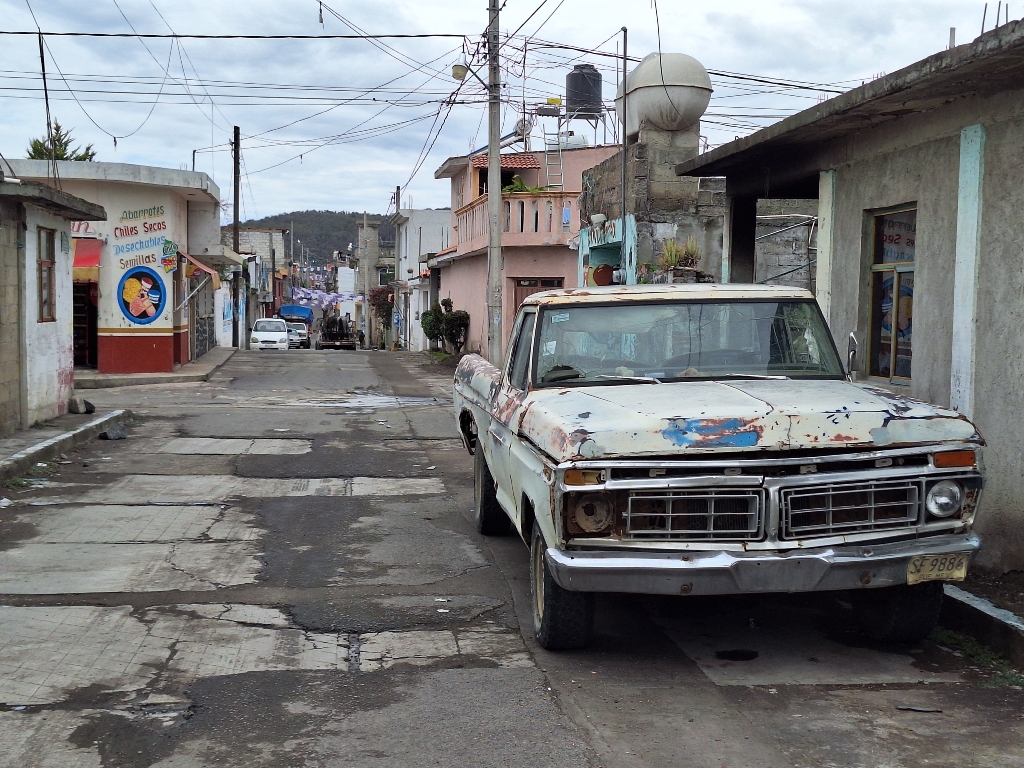
A fairly typical rural street scene
From Natívitas I climbed up the Paso de Cortés. Toward the top of the pass after a long day of climbing the road devolved into a muddy mess. The last few kilometers were difficult but atop the pass I found a police station, which I could camp next to under a roof and the spot even had a table. Such luxuries are fit for a king. In the morning I met Christian who was out mountain biking and we talked about my trip. He had come by car and stopped a few times on the way down the pass to take some pictures of me cycling as I passed him.

Popcatépetl

Me and Popcatépetl
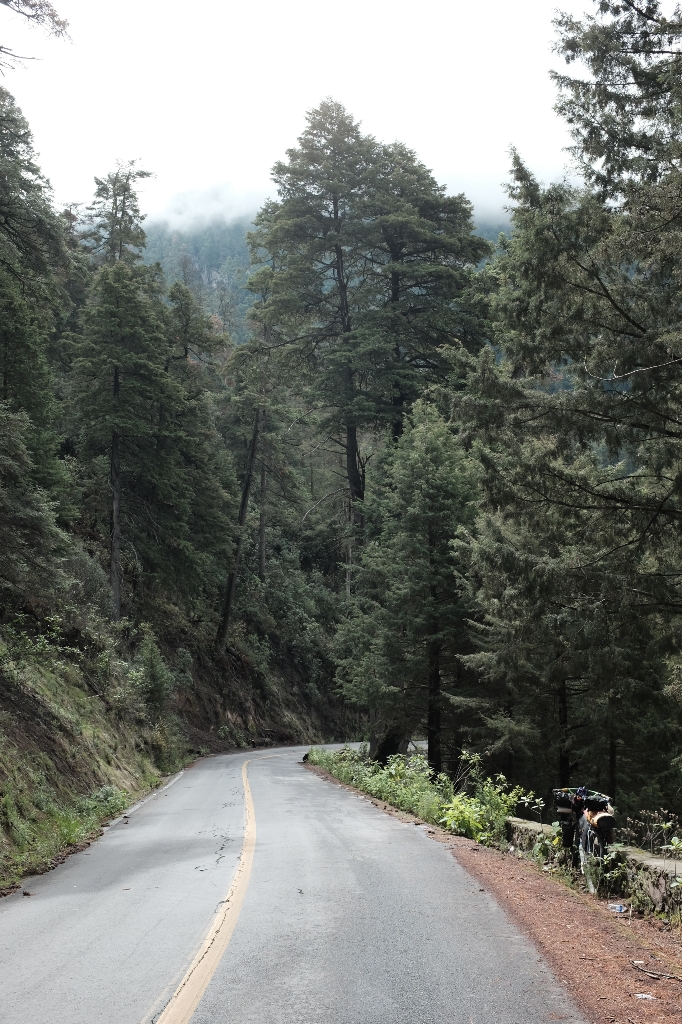
Descending toward CDMX

Thanks, Christian for the photos!
Riding into Mexico City (CDMX) was incredibly frustrating and nauseatingly noisy. Originally my plan was to ride to the outer edge of the metro system and to take a train into the city. Unfortunately, no bikes on trains before 10 PM during the week. I think cycling in urban Mexican traffic has been the most dangerous part of my trip. I’ve found Mexicans to be incredibly friendly people, some of the kindest I’ve met on my trip but something strange happens to them when they get in a car. There is zero respect for cyclists. Every adolescent boy stuck in a grown man’s body has removed the mufflers and emissions systems from his exhaust. Just the noise alone is tiring and then throw in the amount of traffic and the fumes and the volume and you find yourself, mentally drained eating an ice cream in the sanctuary that is a McDonald’s blindly staring out in front of you. “Ok, 30 more kilometers of this.” Eventually I did make it to the center of Mexico City and I spent more than a week in the Roma and Condesa neighborhoods. There I met some lovely people and found it difficult to start cycling again. If I spend a significant amount of time in one place then to start again can take some effort. I need to push myself out the door. This time I left on a Sunday thinking I could exit by train. “Yeah, but not this train.” Here we go again! The Saturday before I left the city I met up once again with a cycling group from Básica Studio and we made a nice loop through the Cumbres del Ajusco area southwest of the city. It felt nice to ride the bike without all of that luggage.
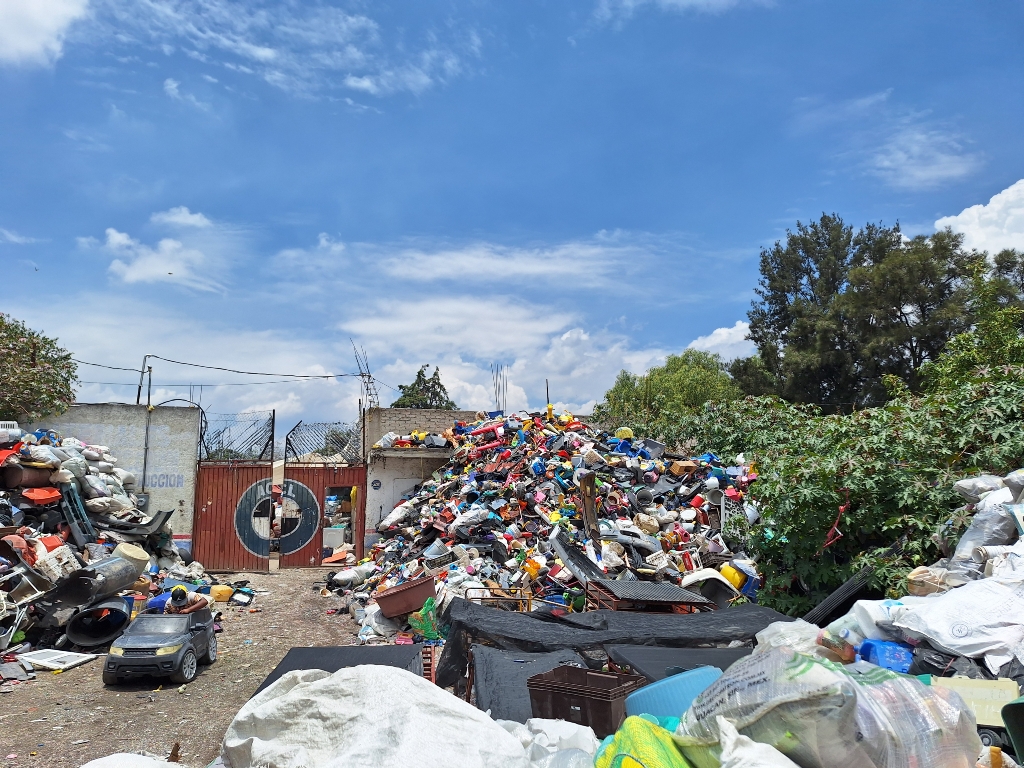
A bunch of stuff

Tlazalpan
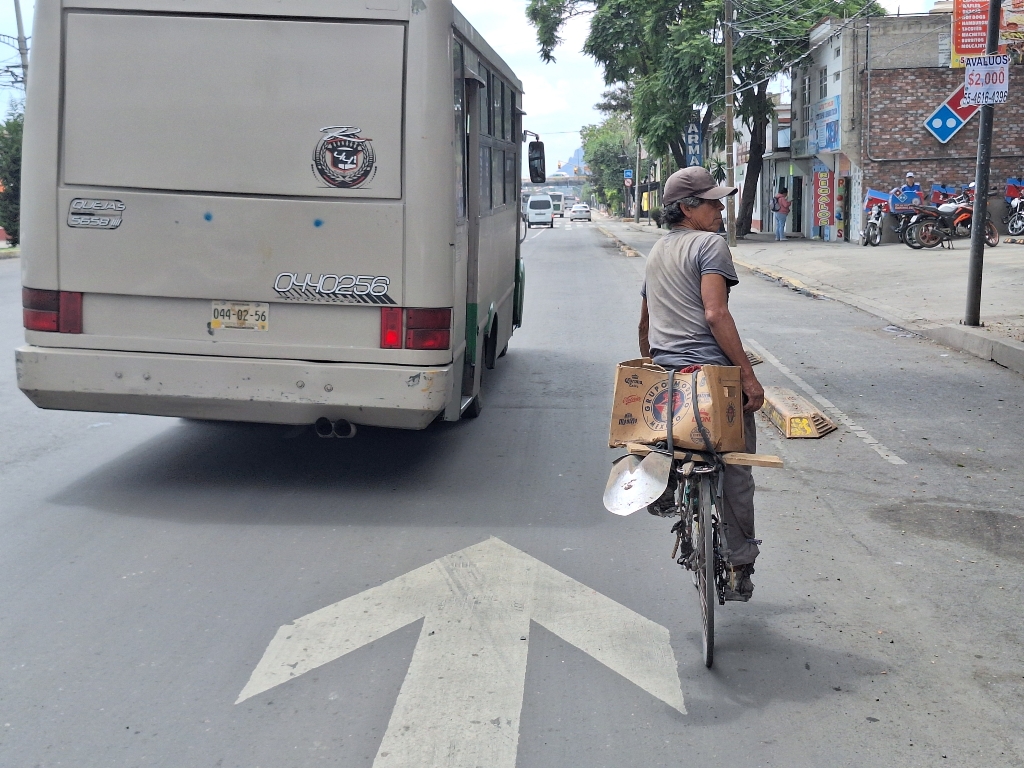
Augustin showing me the way
A few curiosities that I noticed while cycling through Mexico were the quantity of speed bumps and pharmacies. Villages and cities are often riddled with speed bumps that seem to be placed wherever an annoyed homeowner decided to put one. There’s also a huge amount of pharmacies, sometimes a few per block. When hitchhiking or asking for a ride, the phrase to use here is “dame un ride,” literally translated as “give me a ride,” but using the English word for ride. Also, somewhat disconcerting, were the amount of tractor trailers flying confederate battle flags. I wasn’t sure what to make of that one and I don’t really have any answers yet, just hypotheses.

Finally some friendly traffic
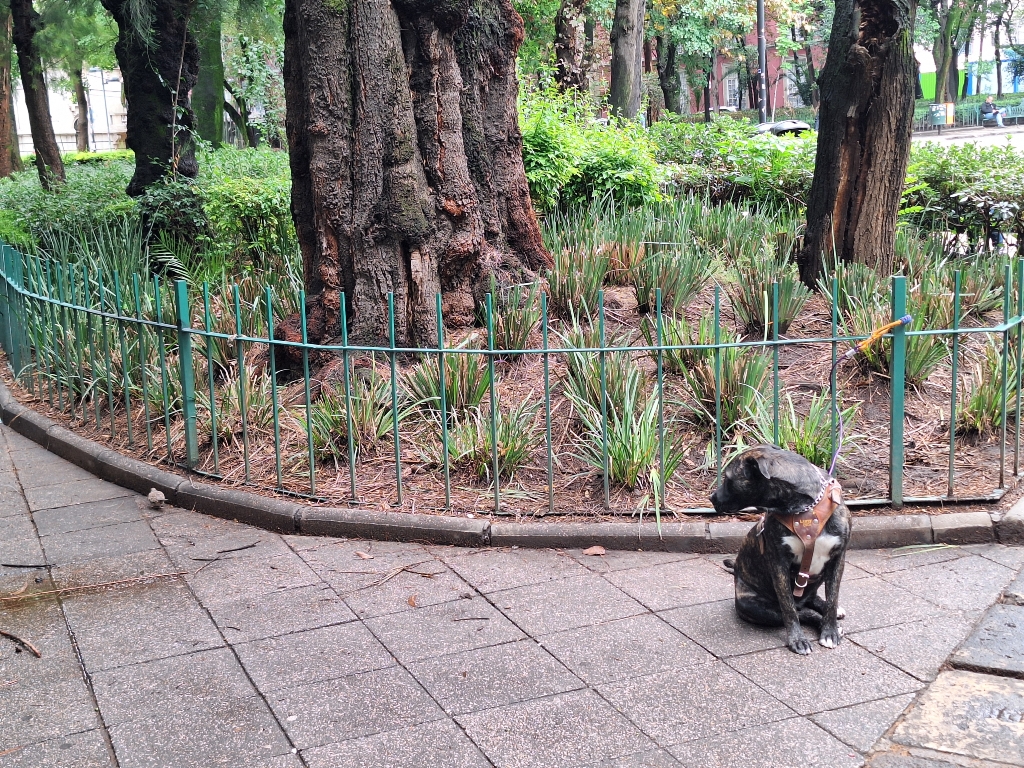
A very gentle pitbull
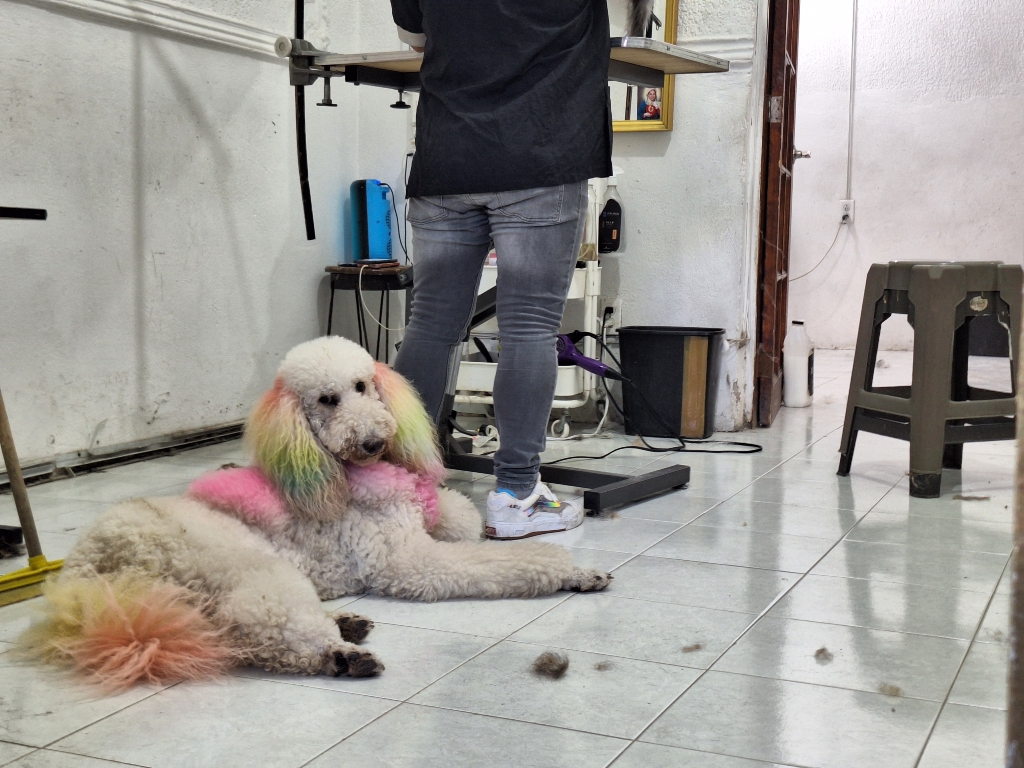
We're in the rich neighborhoods now; Roma, CDMX
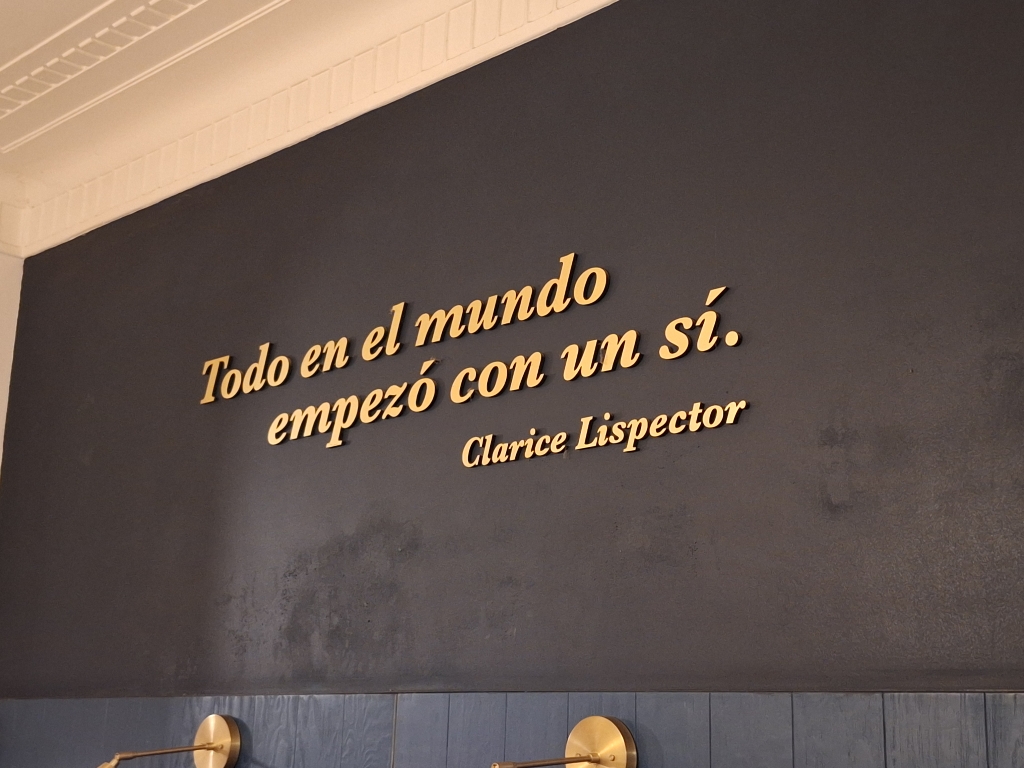
yup!
My pace really picked up after leaving Mexico City. I wasn’t sure yet which route I’d take and all I knew was that I wanted to ride to Mazatlan, Sinaloa because from there I could take a ferry to the Baja Peninsula. I could either ride via Guadalajara or via Durango. My first day out of CDMX I camped at the fire department in Tepeji. It was a great evening as we cooked dinner together and I told them stories from my trip and how much I was enjoying the last few weeks here in Mexico. The next day I met Marco, Emiliano, Ignacio, and Yuri at an Oxxo on the side of the road. I’d stopped to eat an apple in the shade and they had stopped to gas up their motorcycles. We chatted for a while, took some pictures together, and exchanged numbers. They bought me a coffee and some cookies and I told them that these experiences were my favorite part of the trip. I rode the last stretch into Queretaro together with a local cyclist named Gustavo. I found a place to pitch my tent in the ambulance bay of the Red Cross.

Stopping for a coconut
On the road the next day I noticed my front tire going flat as I rolled into Celaya and asked a man if there were any bike shops nearby. I walked the rest of the way to Roberto’s shop; he’d also taken a long cycling trip a few years ago and was excited to help me fix my front tire. He invited me out to lunch but I had to keep moving if I wanted to cover any distance today. I made it to the city of Salamanca and camped at the Red Cross again. This time downwind from a nearby oil refinery. In La Piedad I stayed with a volunteer fire department and we went out for dinner in a firetruck. In Poncitlan I again stayed with the fire department and they had a bed for me in their air conditioned dorm. They had caught a rattlesnake and kept it in a terrarium. It was slightly disconcerting to hear that rattle while you’re laying in bed trying to sleep. I left the firehouse early figuring it best to be out before the shift change. I made my breakfast in a bus stop along the road and found myself smiling and thinking about how rad this trip is.
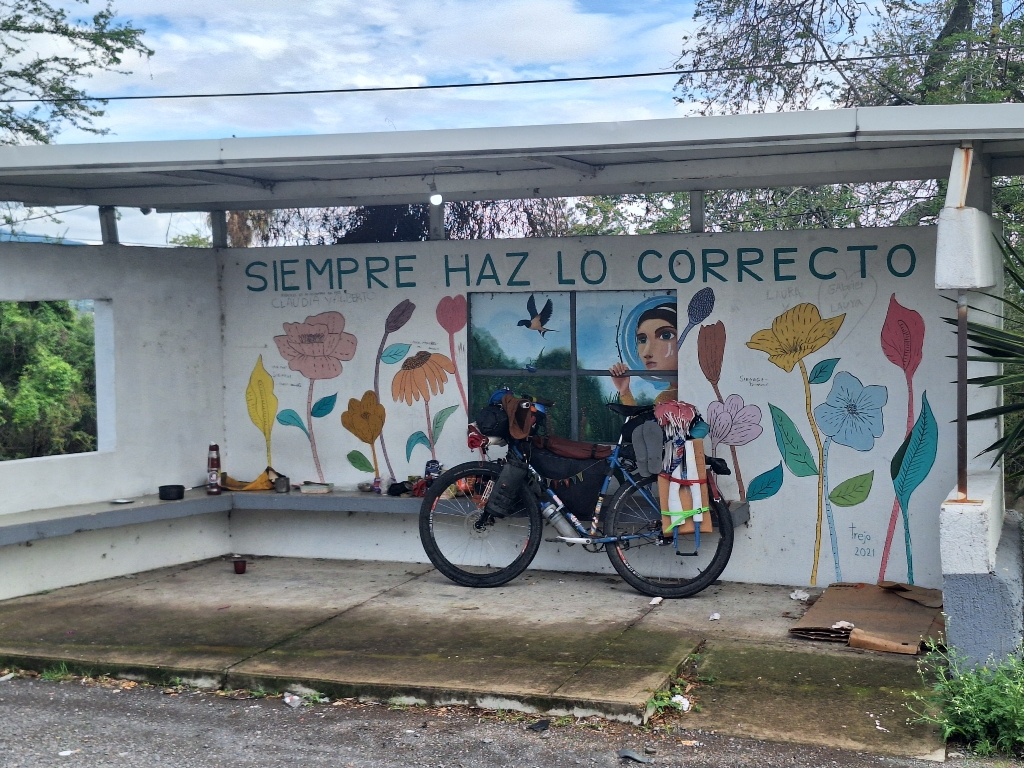
Bus stop breakfast spot
Shortly before the town of Ocotlán I saw a guy and his friend pushing their motorcycle up a hill. I asked if they needed anything and they said they were out of gas. I gave them the rest of what I had in the bottle for my stove (I cook with regular automotive gas) and they had enough to reach the next Pemex station. They assumed I was from the US and asked me where specifically I was from. Before they kick started the bike and rode off, the one guy laughed and slapped the other guy in the chest and said, “te dije, hay buena gente allá también!”
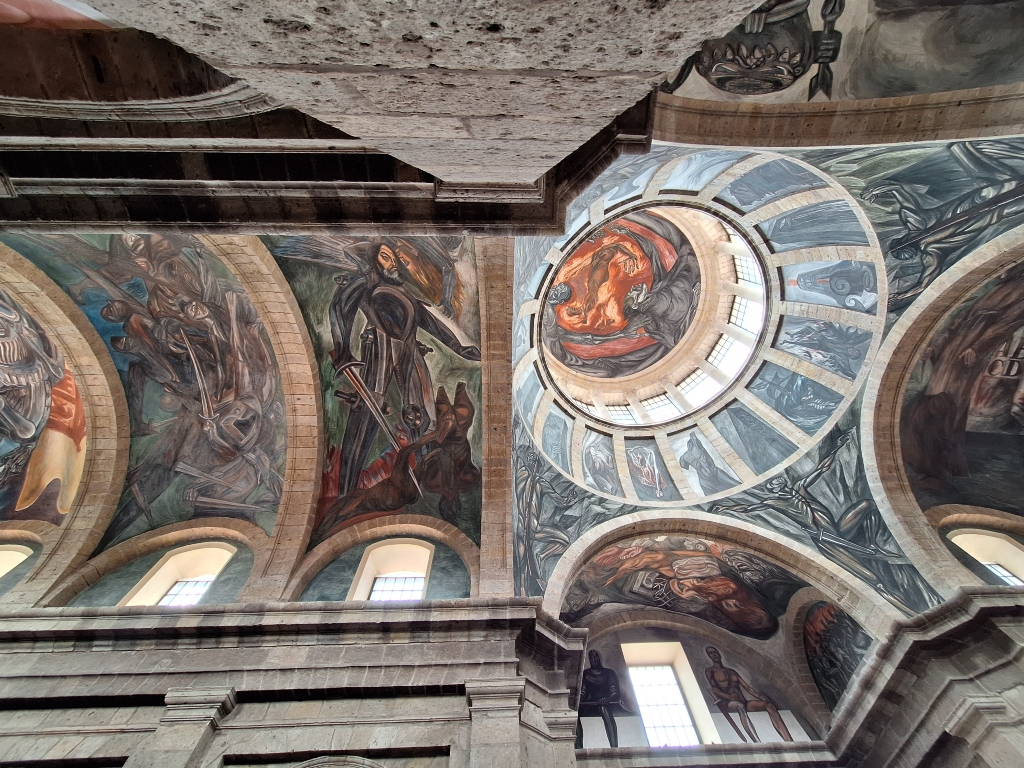
Guadalajara frescos
I rolled into Guadalajara toward the end of the afternoon and stayed with Zander and his dog Rocky for a few days. We had met in San Cristobal and kept in touch. From Guadalajara I rode to Tequila and then to Jala where I camped out in front of the church. I waited for mass to finish and spent the evening chatting with Padre Felipe about my trip and his work in the parish. Unexpectedly, the road became a lot more rural for the next few days. I guess I could’ve known but I just hadn’t studied the map all too well. They were some long, boring days where I was lucky to happen upon a shop or a restaurant. I stopped into whatever restaurants I could find to order a plate of beans and chilaquiles.
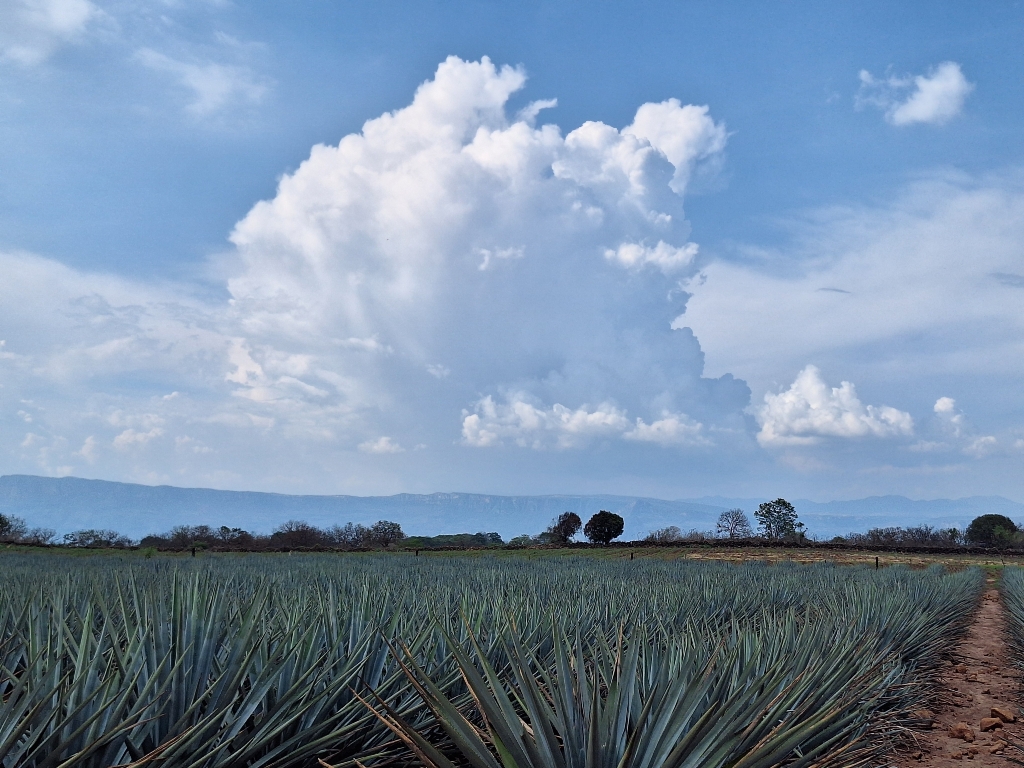
A cool cloud over some agave fields

Padre Felipe campsite
When I eventually rolled into the city of Tepic, the first thing I saw was a Burger King so I went there for a coffee and some WiFi. In line, I met Miguel and Sandra who are both avid cyclists and they insisted that I stay with them. We exchanged numbers, I looked at the map and figured it best to stop early for the day and rest a bit in a comfortable spot. We went out for tacos that evening and had a great time. From Tepic I descended down toward the coast and into the hotter Sinaloan climate. In the town of Palmillas I went to a rural health clinic to ask if I could camp there but they had closed for the day. Fidencio, one of the guys working on renovating the building said I could camp in his yard. The following morning we had a great breakfast of fried robalo before I hit the road. And the final night before reaching Mazatlan I stayed in Ricardo’s wood studio in the town of El Huajote.
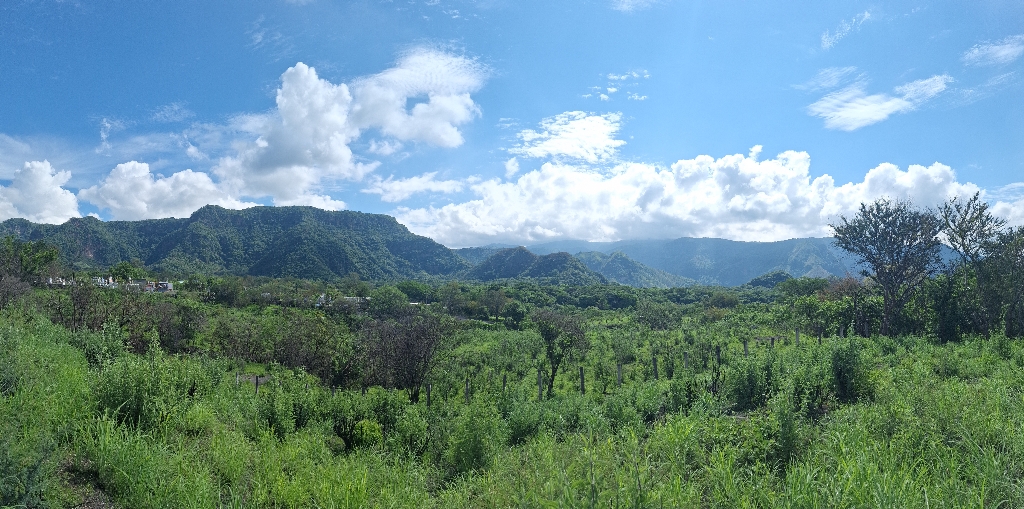
Climbing away from Tequila in the heat
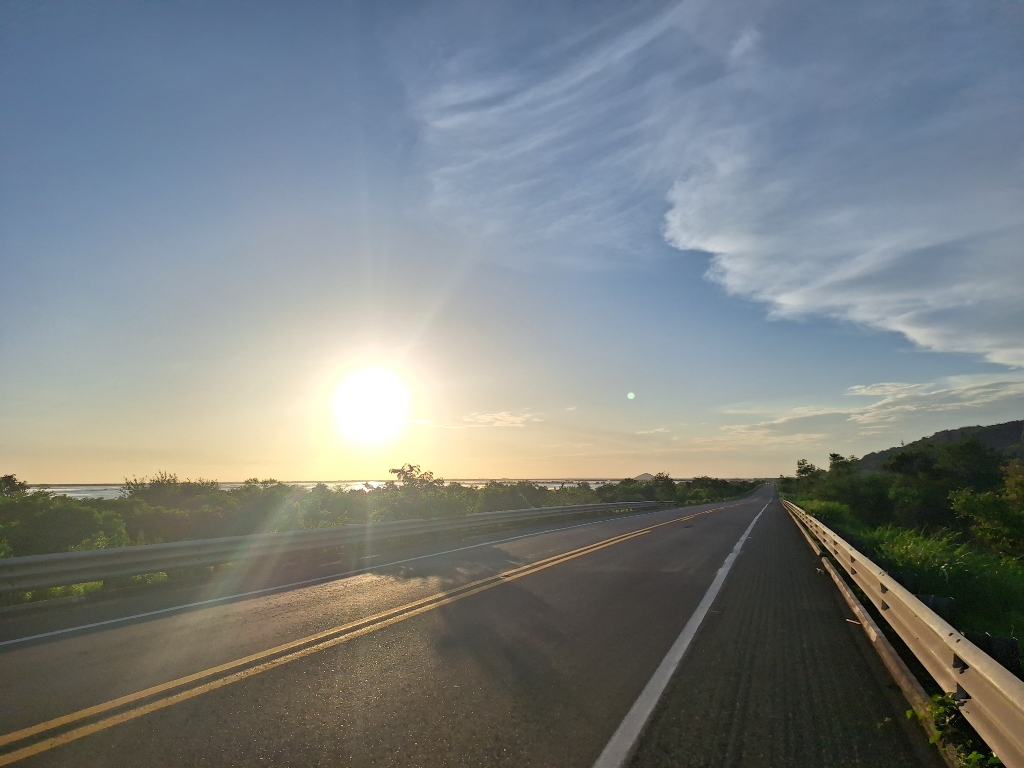
A Sinaloa sunset
Writing this it feels a bit like I’m just listing interactions that I had with people. Maybe it reads that way, too but I really just want to share a small selection of the stories from people helping me out on the road. The Mexicans I’ve met have been incredibly friendly and welcoming and hospitable. People are often impressed when I tell them where and when I started cycling that it makes me wonder about the kilometer, or the moment, or the hill where the trip became something that resonates so much with people? Somewhere between there and here where I am now, it became something more than a bike trip.
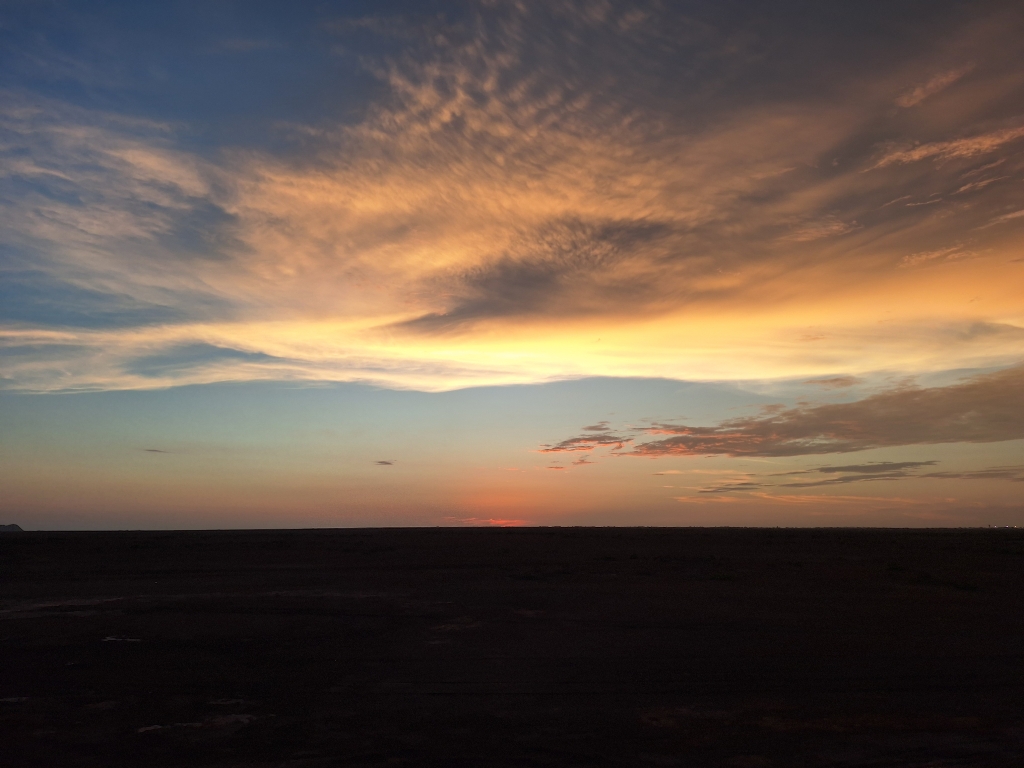
Almost dark, almost at the ferry boat
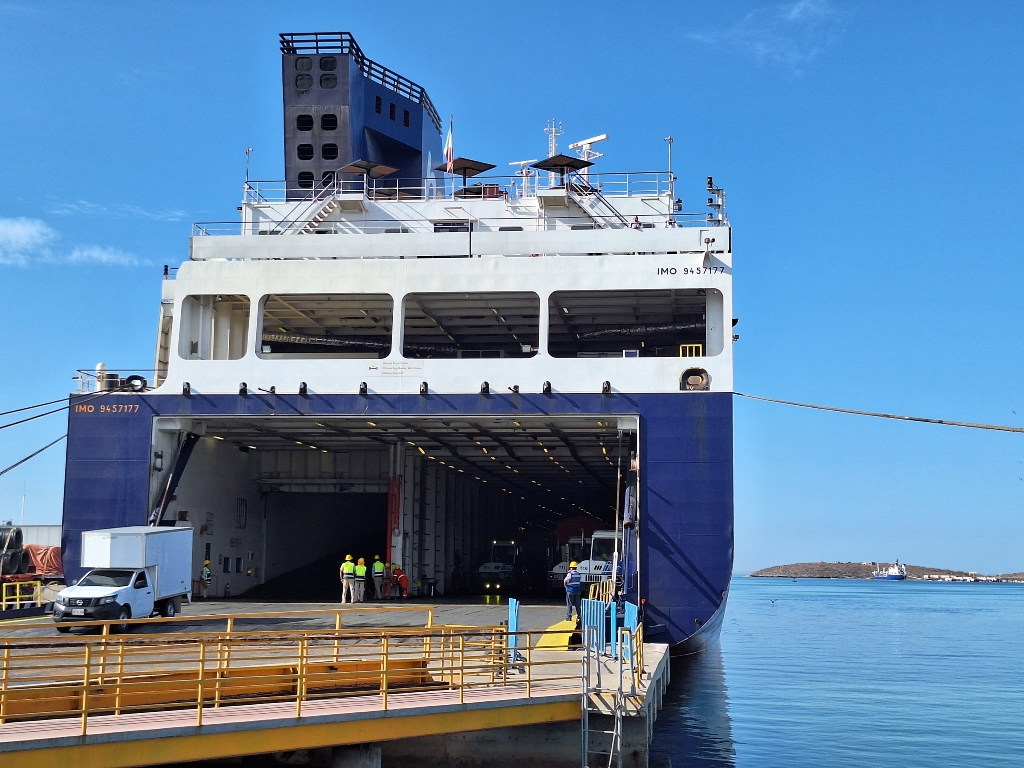
Unloading in Baja California Sur
I rode into Mazatlan, Sinaloa from where the ferry boats depart to the Baja peninsula. Unfortunately, the boats were all booked up for the next 5-10 days and finding a ticket proved difficult. I saw there was a ticket available for tomorrow night but from a city called Topolobampo about a six hour bus ride north. It’d be a lot more stressful having to take the bike on a bus but it could save me quite a lot of time so I ended up choosing this option. Without much trouble, just a lot more hassle, I eventually found myself sitting on a ferry boat ready to set sail for Baja.
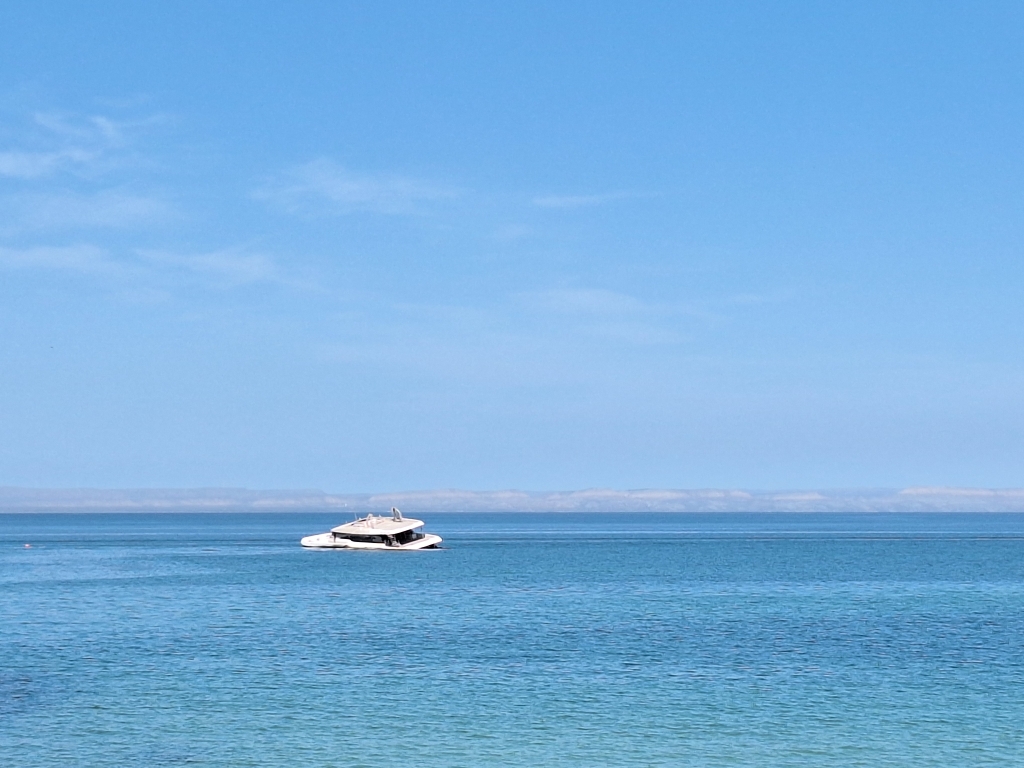
Boat problems
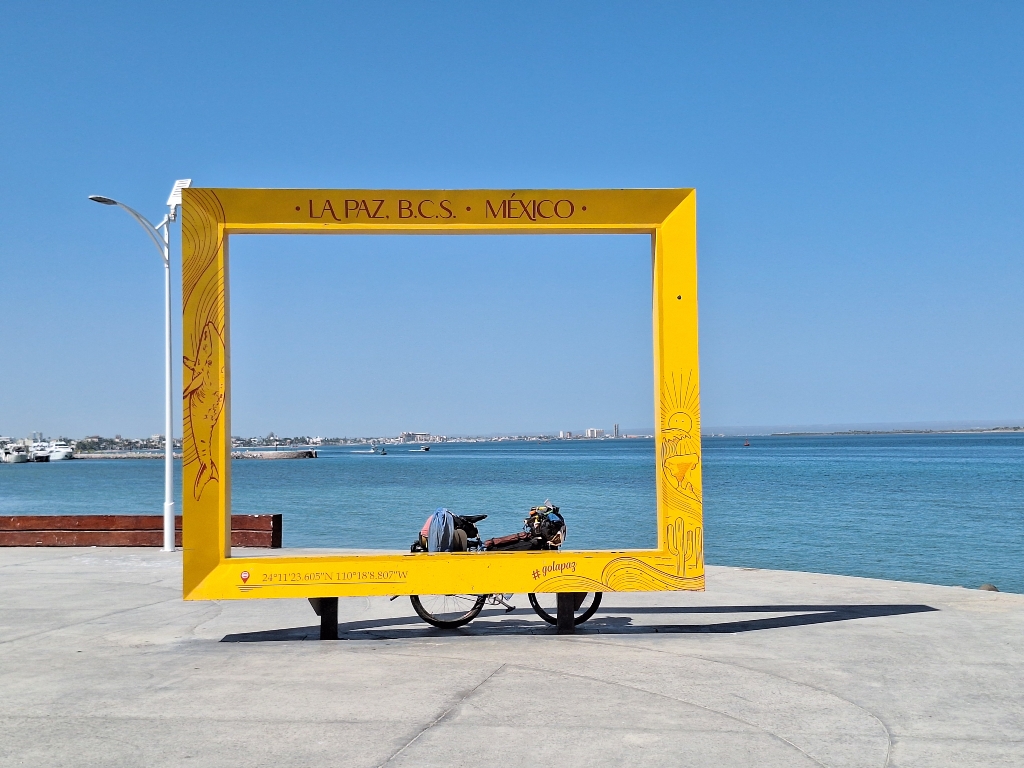
Entering La Paz
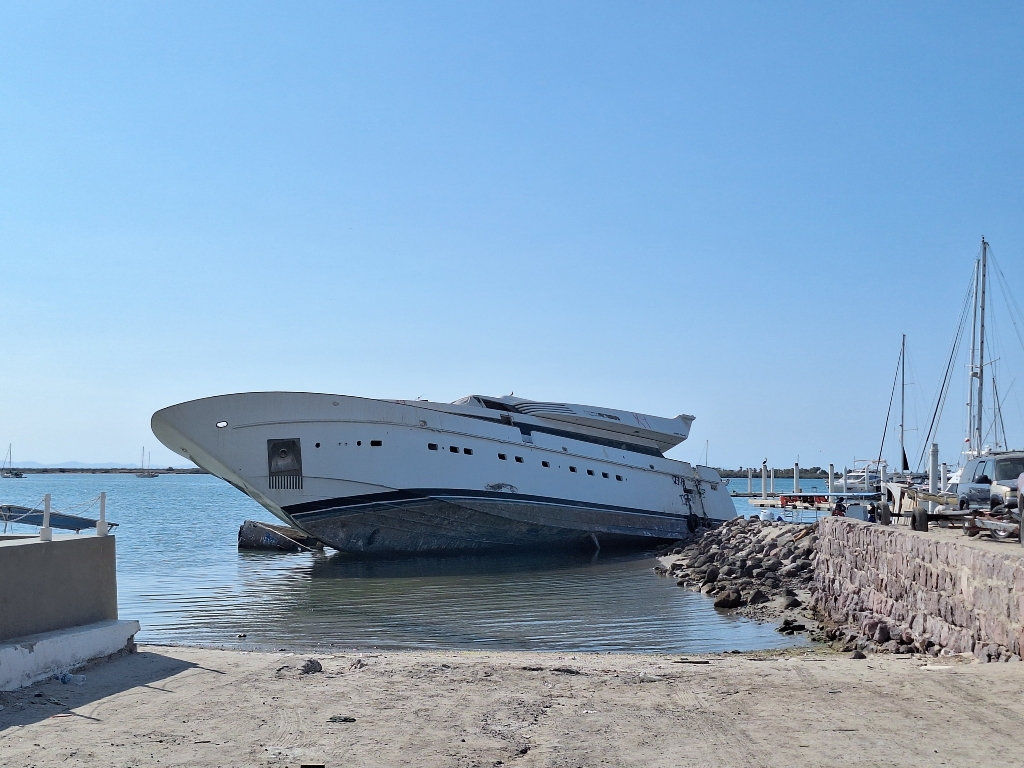
Whoops!
P.S. I also wanted to share a story from Colombia that doesn’t fit here chronologically but that I keep thinking about. If I look back at my map then I know that it was day 360. I had crossed the Rio Magdalena via the bridge at Puerto Berrio the day before and had had a nice dinner with a Dutch couple travelling by motorcycle at Puerto Araujo. I was about one or two days away from some much needed rest in Bucaramanga. It was a day without turns, just about 100 kilometers of one long, straight road. Toward the end of the afternoon I saw a man pushing his bike in the distance coming my way. When I got closer, I noticed he had Down’s Syndrome and that he was pushing his bike because of a flat tire. I told him I could help him fix it; I had some patches. We made some small talk, “where ya comin’ from, where ya going?” The usual. He was on his way home from work. Eventually we got his inner tube patched and everything put back together and I was about all out of small talk so the timing was perfect. He starts riding and the newly patched inner tube exploded entirely. No worries, let’s have a look. We open the tire back up and the inner tube is completely shredded. I don’t have patches big enough and his tires are a different size so I can’t give him a new inner tube but his reaction to the situation is what stayed with me. This guy just couldn’t stop laughing. It’s feeling a bit awkward now from my side because I don’t have the words to explain, “hey man, I can’t help you, you’re gonna have to keep walking,” in Spanish but he gets it. And I think in part he’s laughing at me not knowing what to say and at the situation itself. He thanks me for the effort and as I ride away I just hear him laughing. I still think about that guy and his good attitude from time to time.